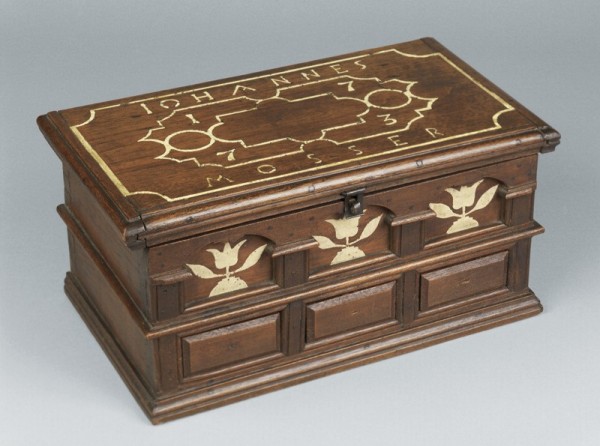
Miniature chest, made for Johannes Mosser, Lancaster County, Pennsylvania, 1773. Walnut and sulfur inlay with tulip poplar; iron. H. 7 1/4", W. 14 3/4", D. 8 5/8". (Courtesy, Winterthur Museum; photo, Laszlo Bodo.)
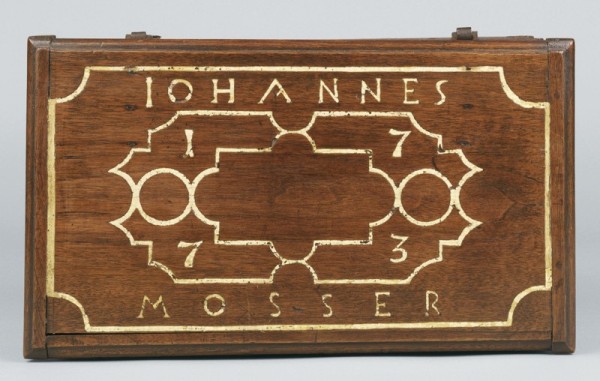
Lid of the miniature chest illustrated in fig. 1.

Map of Pennsylvania. (Courtesy, Winterthur Museum.)
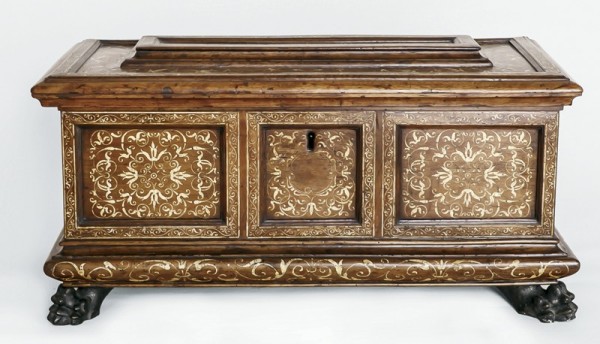
Chest, Bologna, Italy, ca. 1550. Walnut and probable orpiment inlay. H. 16 1/8", W. 32 1/4", D. 14 1/2". (Courtesy, Museum Angewandte Kunst, Frankfurt am Main; photo, Ute Kunze.)
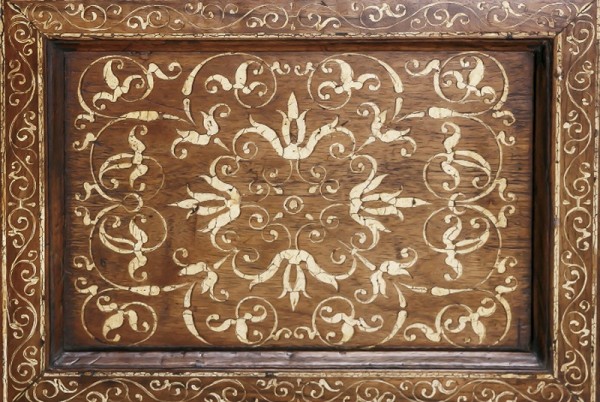
Detail of the inlay on the front of the chest illustrated in fig. 4.
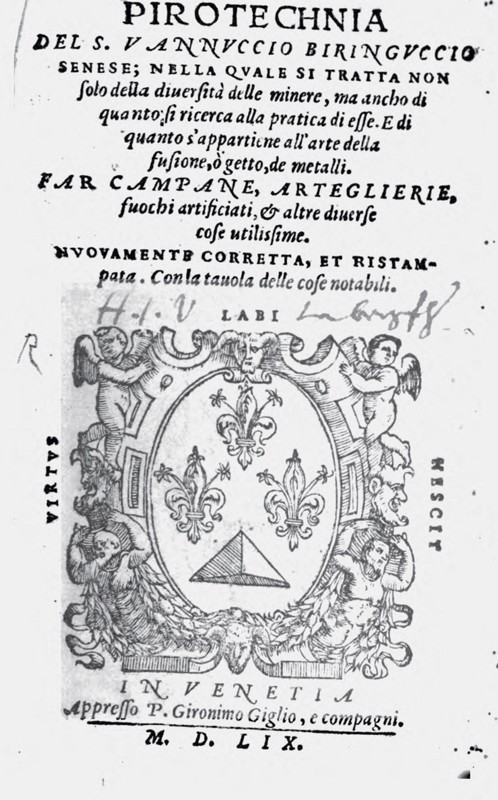
Title page of De la pirotechnia, written by Vannoccio Biringuccio, 4th edition, printed by P. Gironimo Giglio, Venice, Italy, 1559. (Courtesy, Bayerische Staatsbibliothek, Munich.)
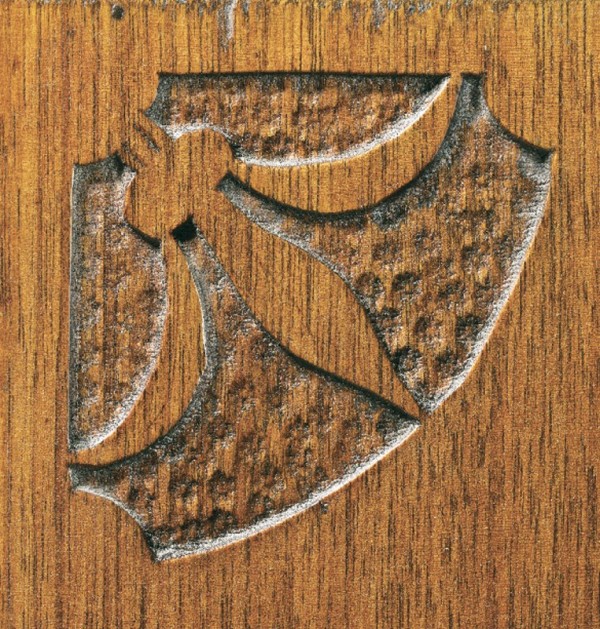
Detail of a relief carved fleur-de-lis on the schrank illustrated in fig. 38. (Photo, Gavin Ashworth.)
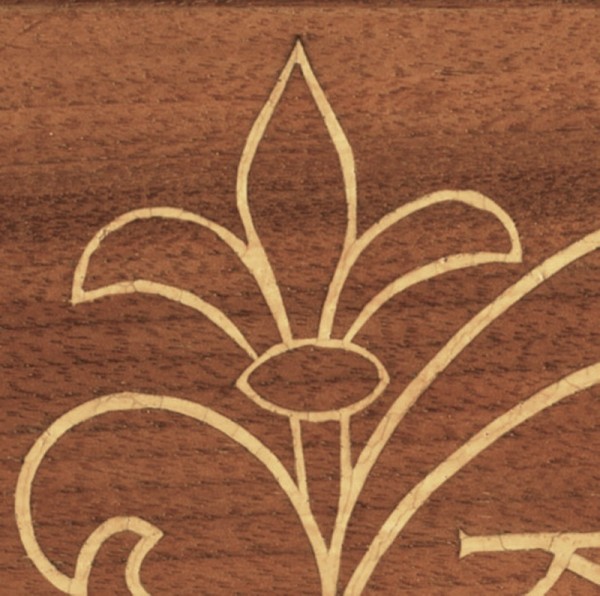
Detail of a sulfur-inlaid fleur-de-lis on the schrank illustrated in fig. 27. (Photo, Gavin Ashworth.)
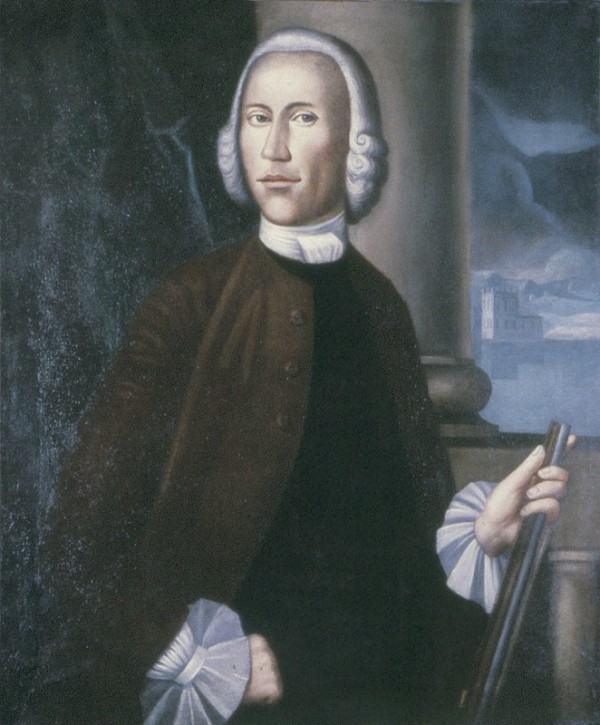
Portrait of William Henry, attributed to Benjamin West, Lancaster, Pennsylvania, ca. 1754. Oil on canvas. 36 3/4" x 30 1/2". (Courtesy, Philadelphia History Museum at the Atwater Kent, Historical Society of Pennsylvania Collection.)
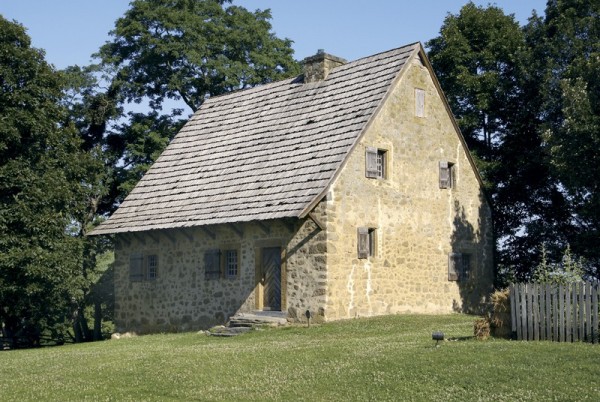
House of Christian Herr, West Lampeter Township, Lancaster County, Pennsylvania, 1719. (Courtesy, 1719 Hans Herr House & Museum; photo, Winterthur Museum, Laszlo Bodo.) The stone lintel above the door is inscribed “17 CH HR 19.”
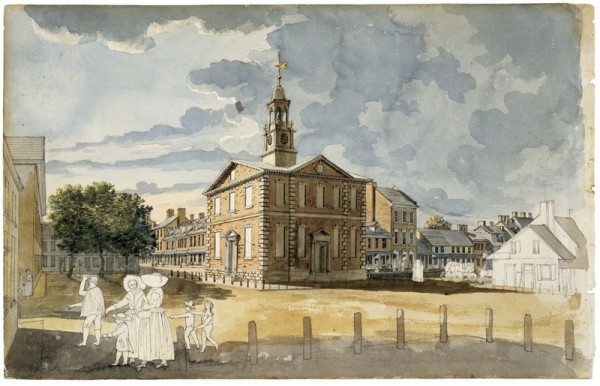
Benjamin Henry Latrobe, view of the Lancaster County Courthouse (built 1787), Lancaster, Pennsylvania, ca. 1801. Watercolor, pencil, pen and ink on laid paper. 8" x 12 3/4". (Courtesy, Maryland Historical Society, 1960.108.1.8.8.)

Tall clock, made for Andreas and Catharina Beierle, probably Lancaster, Lancaster County, Pennsylvania, 1745. Black walnut with tulip poplar. H. 91 1/4", W. 21 3/4", D. 12 1/4". (Private collection; photo, Winterthur Museum, Laszlo Bodo.) The base molding is replaced and the movement is not original to the case.
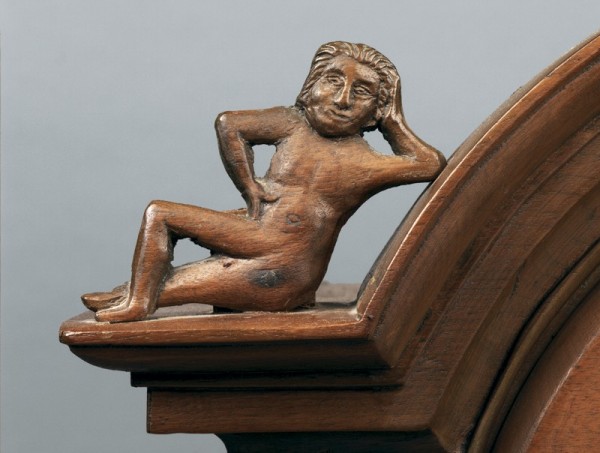
Detail of the carving on the tall clock illustrated in fig. 12.

Pendulum door of the clock illustrated in fig. 12.
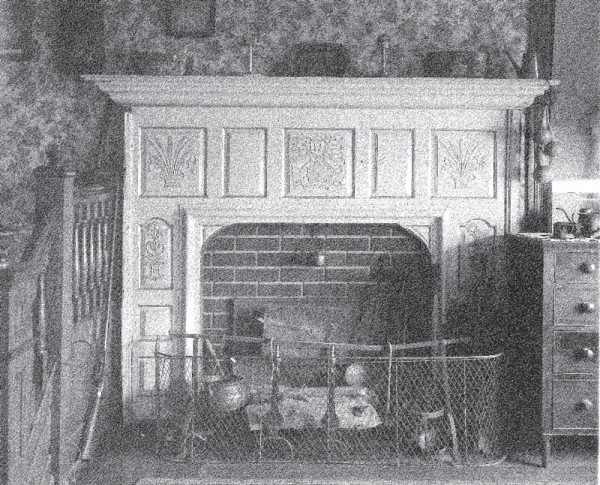
Mantel, probably Lancaster, Lancaster County, Pennsylvania, 1746. (Whereabouts unknown; photo, Raymond J. Brunner.) This photograph was taken in the shop of antiques dealer Hattie Brunner in Reinholds, Lancaster County.

Schrank, probably made for Michael and Anna Margaretha Fordney, Lancaster, Lancaster County, Pennsylvania, 1758. Walnut and pewter inlay with pine and tulip poplar; brass, iron. H. 84", W. 78", D. 21 3/4". (Courtesy, Clint and Cindy McCauley; photo, Pook & Pook.) The feet are a later addition.
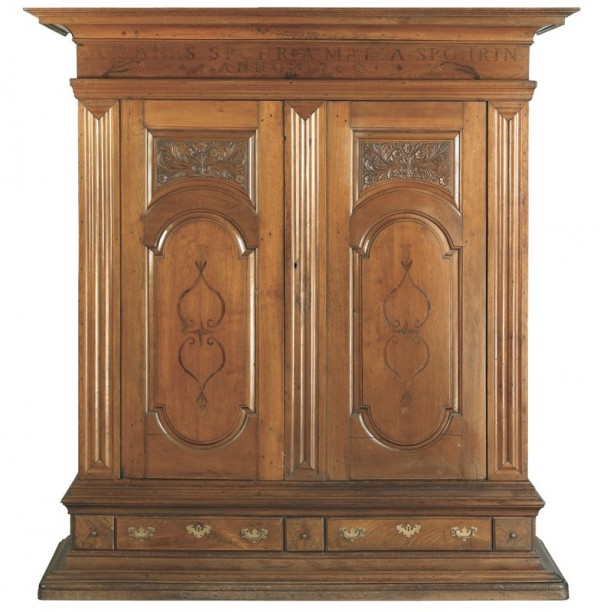
Schrank, made for Johannes and Anna Maria Spohr, Lancaster, Lancaster County, Pennsylvania, 1760. Walnut and mixed-wood inlay with tulip poplar; brass. H. 85", W. 71 1/2", D. 26". (Courtesy, Philadelphia Museum of Art; photo, Pook & Pook.)
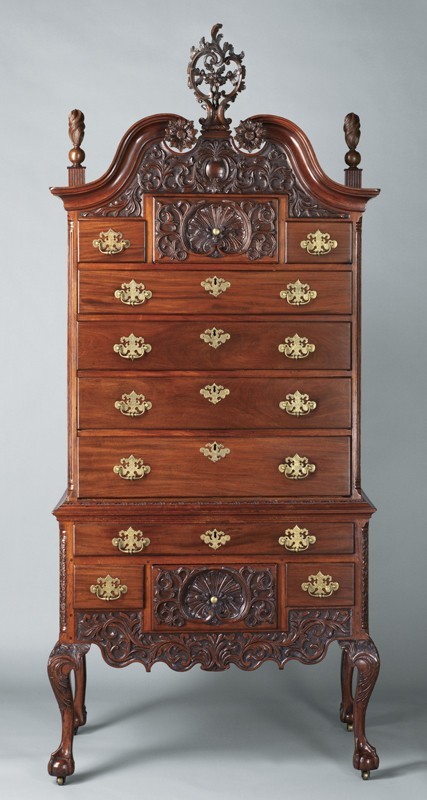
High chest, made for Matthias Slough, Lancaster, Lancaster County, Pennsylvania, 1770–1785. Mahogany with tulip poplar; brass. H. 96", W. 42", D. 24". (Courtesy, LancasterHistory.org, Heritage Center Collection, bequest of the estate of George J. Finney; photo, Winterthur Museum, Laszlo Bodo.)

Schrank, made for Christian and Veronica Herr, Lancaster County, Pennsylvania, 1763. Walnut and sulfur inlay with tulip poplar and oak; brass, iron. H. 86", W. 84 1/2", D. 30 1/4". (Private collection; photo, Gavin Ashworth.)
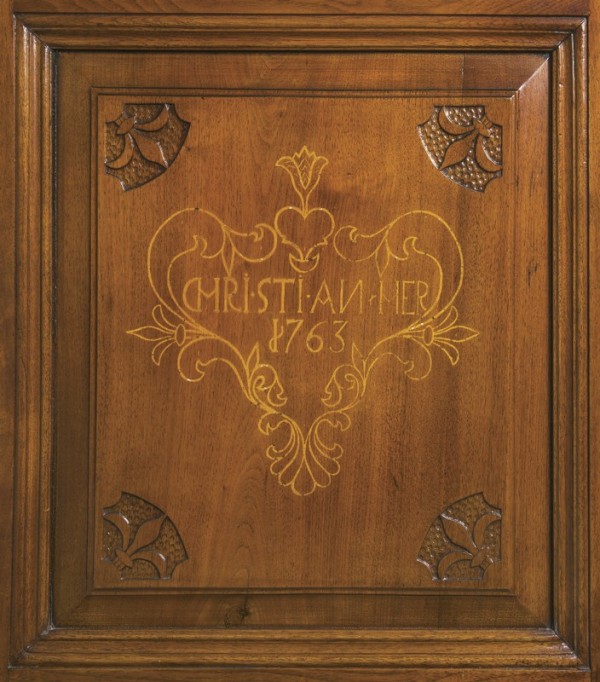
Detail of the sulfur inlay on the schrank illustrated in fig. 19. (Photo, Gavin Ashworth.)
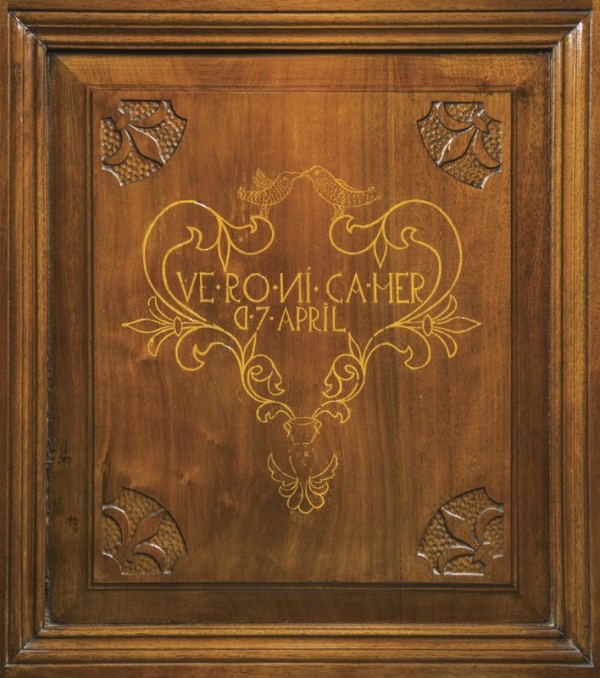
Detail of the sulfur inlay on the schrank illustrated in fig. 19. (Photo, Gavin Ashworth.)
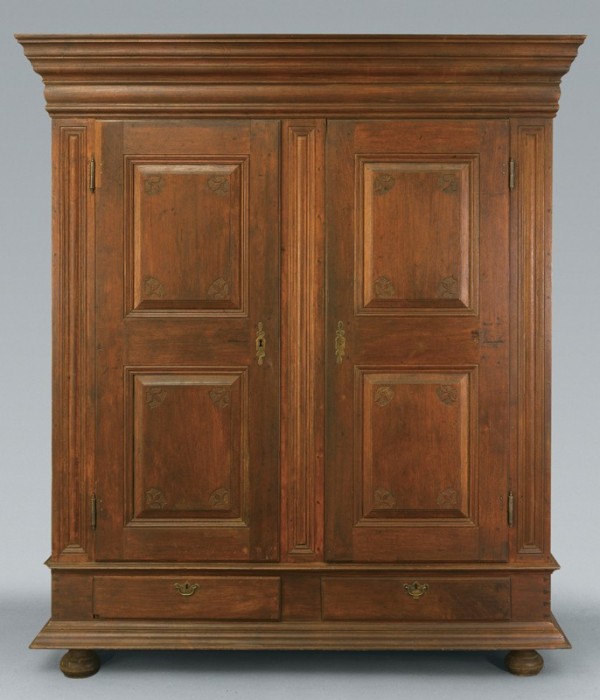
Schrank, Lancaster County, Pennsylvania, ca. 1765. Walnut; brass, iron. H. 85 1/2", W. 71 1/2", D. 26". (Private collection; photo, copyright 1995 Christie’s Limited.)
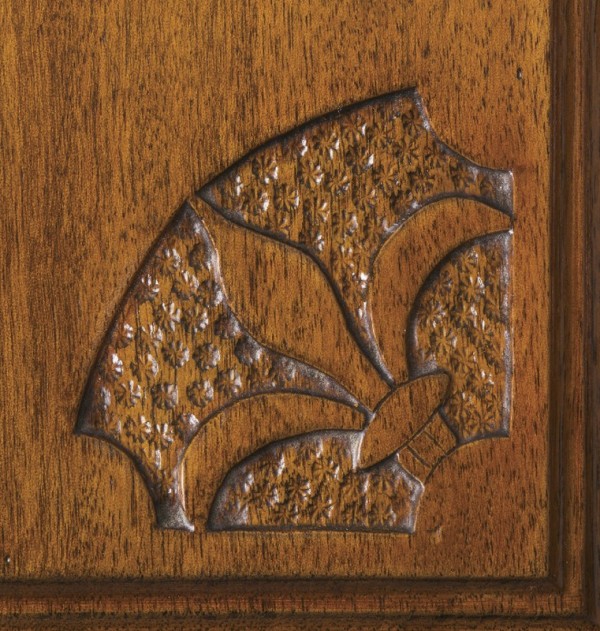
Detail of the carved fleur-de-lis on the schrank illustrated in fig. 19. (Photo, Gavin Ashworth.)
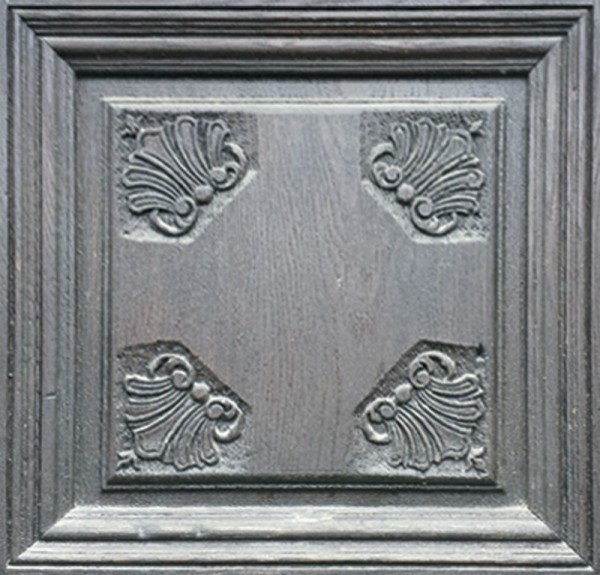
Detail of the carving on the door of a building in Hildesheim, Germany, ca. 1730. (Photo, Lisa Minardi.)
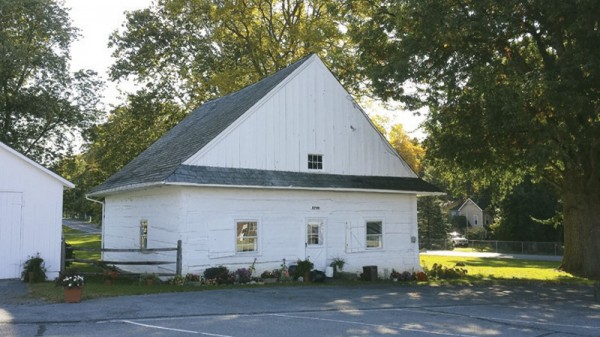
Landisville Mennonite Meetinghouse, East Hempfield Township, Lancaster County, Pennsylvania, ca. 1740. (Photo, Lisa Minardi.)
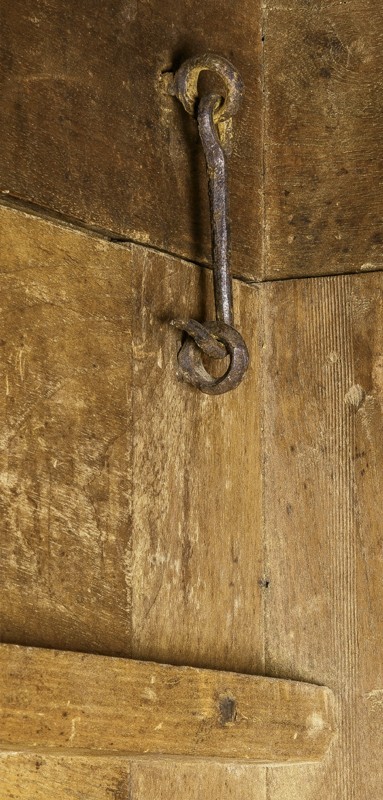
Detail of a wrought iron hook inside the schrank illustrated in fig. 34. (Photo, Winterthur Museum, James Schneck.)
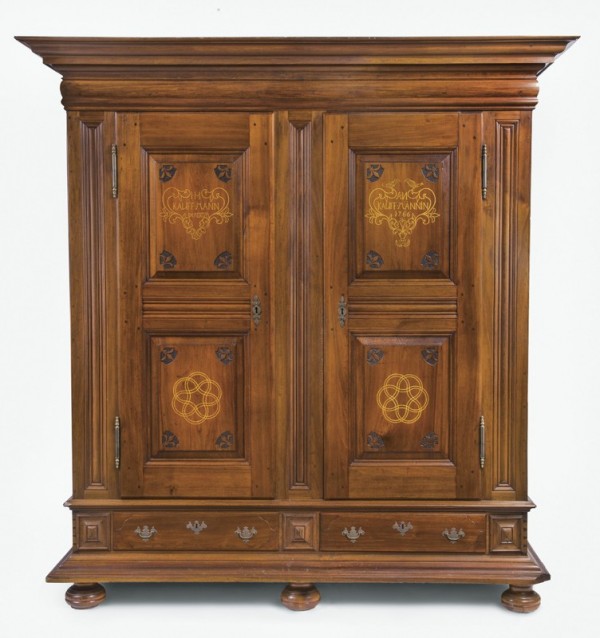
Schrank, made for Johannes and Anna Kauffmann, Lancaster County, Pennsylvania, 1766. Walnut and sulfur inlay with tulip poplar and oak; brass, iron. H. 89", W. 84", D. 30". (Courtesy, Pennsylvania Historical and Museum Commission, State Museum of Pennsylvania; photo, Gavin Ashworth.)
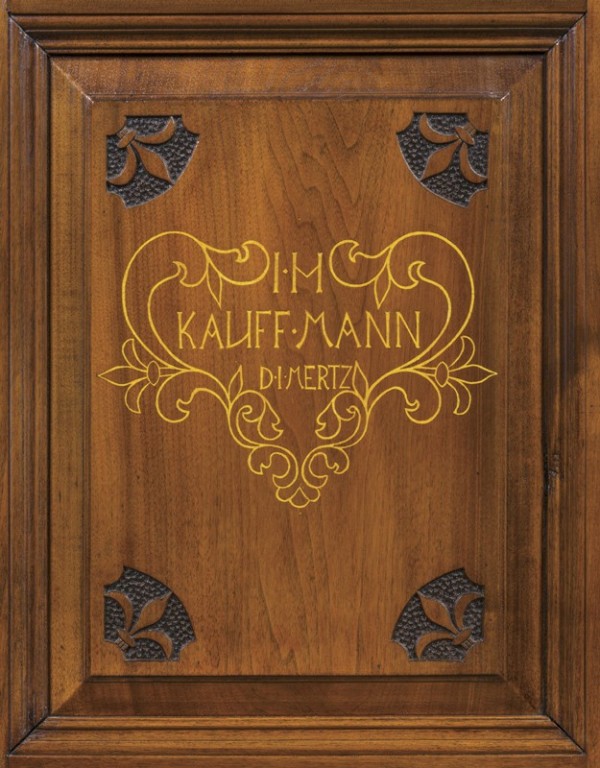
Detail of the inlay on the schrank illustrated in fig. 27. (Photo, Gavin Ashworth.)
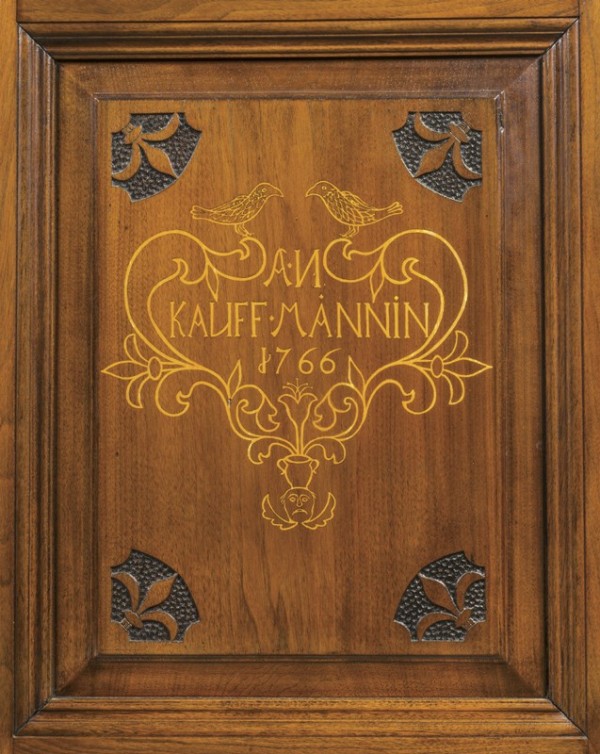
Detail of the inlay on the schrank illustrated in fig. 27. (Photo, Gavin Ashworth.)

Detail of the inlay on the schrank illustrated in fig. 27. (Photo, Gavin Ashworth.)
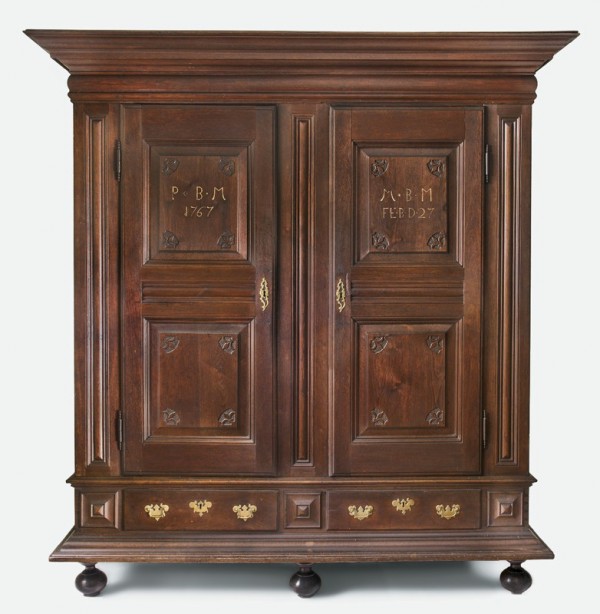
Schrank, probably made for Peter and Maria Bachmann, Lancaster County, Pennsylvania, 1767. Walnut and sulfur inlay with tulip poplar and oak; brass, iron. H. 89", W. 84 1/4", D. 30". (Private collection; photo, Gavin Ashworth.) The feet are replaced.
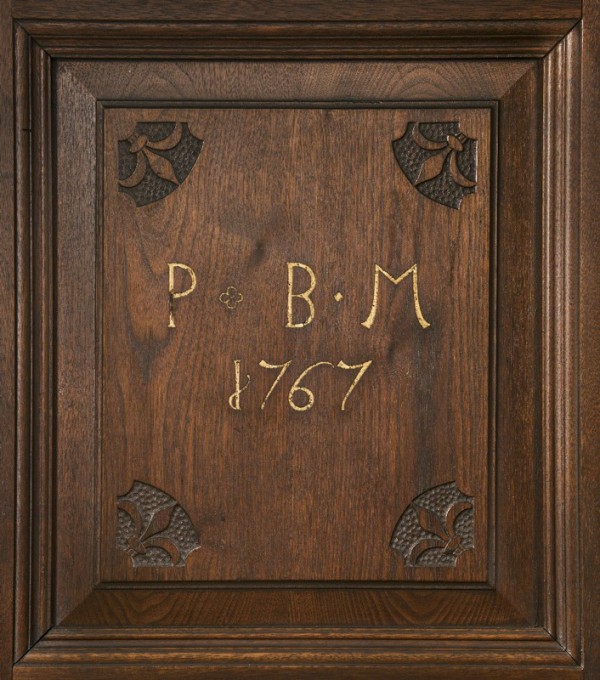
Detail of the inlay on the schrank illustrated in fig. 31. (Photo, Gavin Ashworth.)
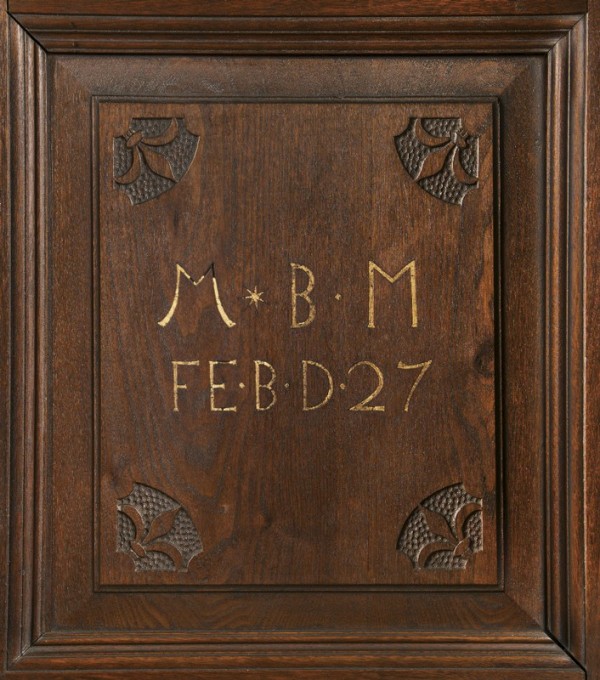
Detail of the inlay on the schrank illustrated in fig. 31. (Photo, Gavin Ashworth.)

Schrank, made for Emanuel and Mary Herr, Lancaster County, Pennsylvania, 1768. Walnut and sulfur inlay with tulip poplar. H. 89 1/2", W. 85 3/4", D. 30 1/2". (Courtesy, Winterthur Museum; photo, Laszlo Bodo.)
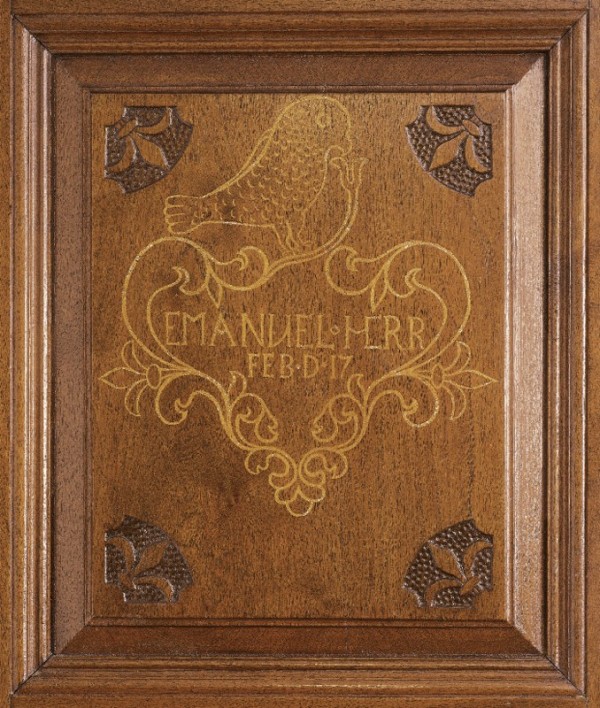
Detail of the inlay on the schrank illustrated in fig. 34. (Photo, Winterthur Museum, James Schneck.)

Detail of the inlay on the schrank illustrated in fig. 34. (Photo, Winterthur Museum, James Schneck.)

Detail of the carving at the base of the schrank illustrated in fig. 34. (Photo, Winterthur Museum, James Schneck.)
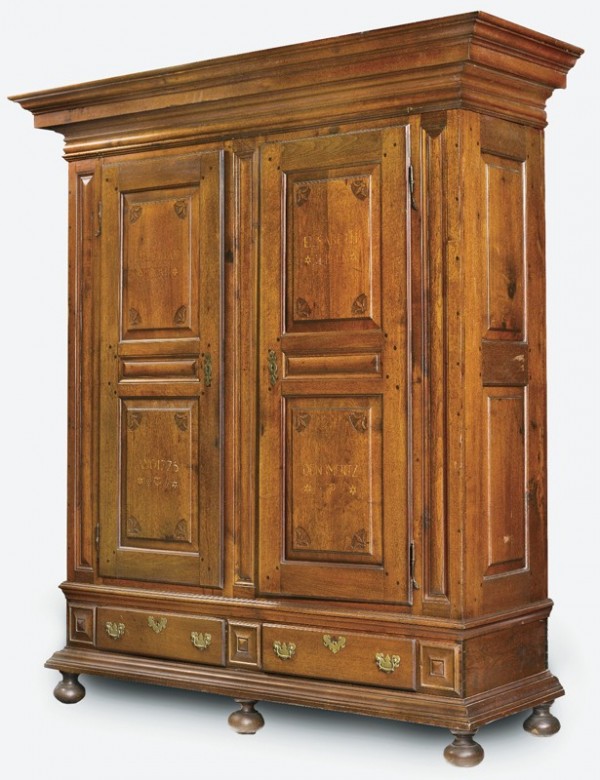
Schrank, made for Abraham and Elisabeth Reist, Lancaster County, Pennsylvania, 1775. Walnut and sulfur inlay with pine; iron, brass. H. 91", W. 86", D. 31". (Courtesy, LancasterHistory.org, Heritage Center Collection, acquired through the generosity of the James Hale Steinman Foundation; photo, Gavin Ashworth.)

Detail of the inlay on the schrank illustrated in fig. 38. (Photo, Gavin Ashworth.)

Detail of the inlay on the schrank illustrated in fig. 38. (Photo, Gavin Ashworth.)

Detail of the inlay on the schrank illustrated in fig. 38. (Photo, Gavin Ashworth.)

Detail of the inlay on the schrank illustrated in fig. 38. (Photo, Gavin Ashworth.)
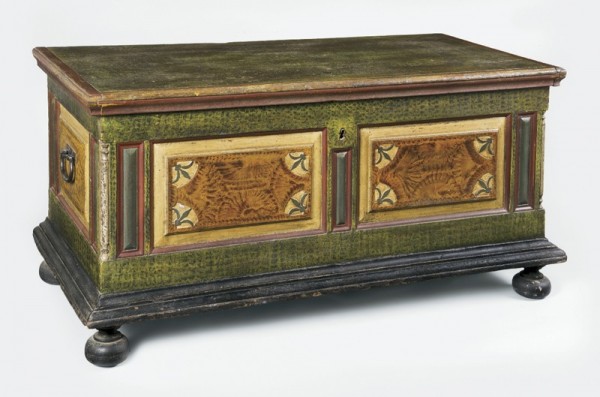
Chest, Lancaster County, Pennsylvania, ca. 1765. White pine; paint; iron. H. 25 1/2", W. 52", D. 24 1/2". (Courtesy, Clarke Hess; photo, Gavin Ashworth.) The paint is restored.

Detail of the chest illustrated in fig. 43. (Photo, Gavin Ashworth.)

Chest, Lancaster County, Pennsylvania, ca. 1765. White pine; paint; brass, iron. H. 26 1/4", W. 53 1/4", D. 27 1/8". (Private collection; photo, David Bohl.) The paint is restored.
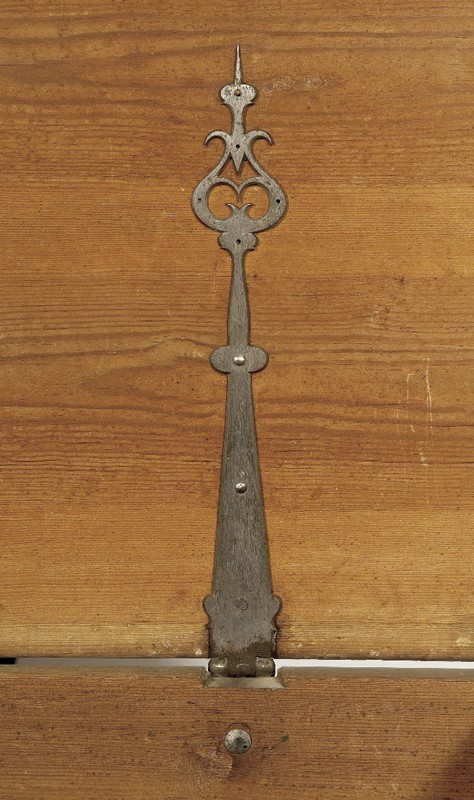
Detail of a hinge inside the chest illustrated in fig. 45.

Chest, probably made for Michael Kauffman, Lancaster County, Pennsylvania, 1765. Walnut and sulfur inlay; iron. H. 25 5/8", W. 51 1/2", D. 24 3/4". (Courtesy, Rocky Hill Collection; photo, Gavin Ashworth.) The feet are replaced.
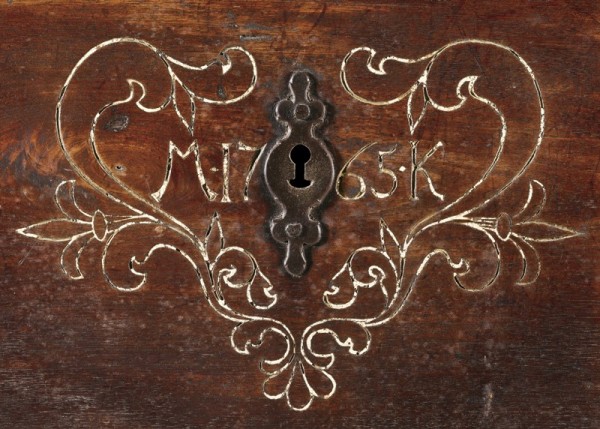
Detail of the inlay on the chest illustrated in fig. 47. (Photo, Gavin Ashworth.)
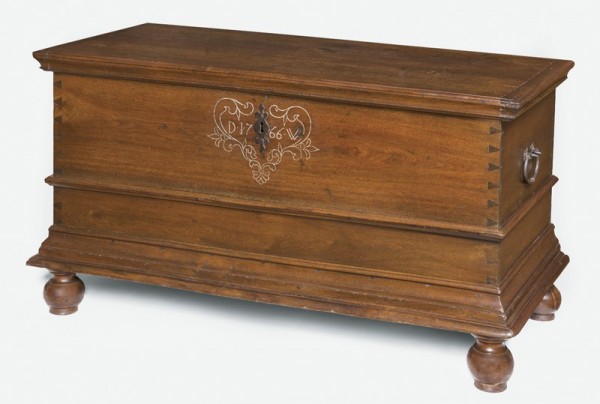
Chest, possibly made for Daniel Wolf, Lancaster County, Pennsylvania, 1766. Walnut and sulfur inlay with white pine; iron. H. 27 1/4", W. 52", D. 24". (Private collection; photo, Gavin Ashworth.) The feet are replaced.

Detail of the inlay on the chest illustrated in fig. 49. (Photo, Gavin Ashworth.)

Chest, made for “I D,” Lancaster County, Pennsylvania, 1768. Walnut and sulfur inlay; iron. H. 25 1/8", W. 51 7/8", D. 24 7/8". (Private collection; photo, Gavin Ashworth.)

Detail of the inlay on the chest illustrated in fig. 51. (Photo, Gavin Ashworth.)
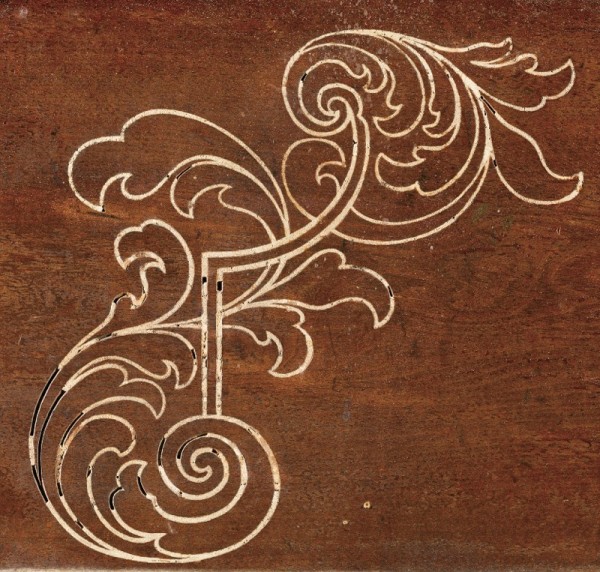
Detail of the inlay on the chest illustrated in fig. 51. (Photo, Gavin Ashworth.)

Detail of a foot on the chest illustrated in fig. 51. (Photo, Gavin Ashworth.)

Tall clock, probably made for Frederick Stone, movement signed by Rudolph Stoner, Lancaster, Lancaster County, Pennsylvania, 1762. Cherry, mixed-wood inlay, and pewter inlay with tulip poplar. H. 101 1/2", W. 21", D. 11 1/2". (Chipstone Foundation; photo, Gavin Ashworth.) The feet are replaced and a board has been added between the cornice and sarcophagus.

Hood of the clock illustrated in fig. 55. (Photo, Gavin Ashworth.)
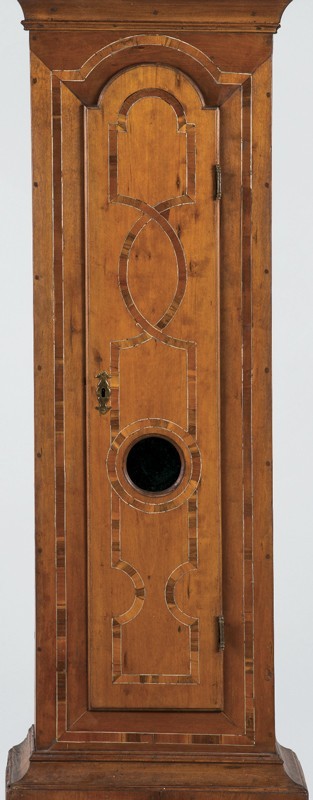
Pendulum door of the clock illustrated in fig. 55. (Photo, Gavin Ashworth.)

Pair of candlesticks, marked by Johann Christoph Heyne, Lancaster, Lancaster County, Pennsylvania, 1755–80. Pewter. H. 22, W. 7 3/4", D. 8 5/8". (Courtesy, Winterthur Museum; photo, Gavin Ashworth.)

Tall clock, made for the Eaby family, movement signed by Christian Forrer, Lampeter, Lancaster County, Pennsylvania, ca. 1765. Walnut and mixed-wood inlay with walnut; brass. H. 92 1/2", W. 19 3/4", D. 13". (Courtesy, Carolyn C. Wenger; photo, Gavin Ashworth.) The feet are replaced; the broken scroll pediment is a later addition.

Hood of the clock illustrated in fig. 59. (Photo, Gavin Ashworth.)

Tall clock, made for Peter Ferree, movement signed by Rudolph Stoner, Lancaster, Lancaster County, Pennsylvania, 1765. Cherry and sulfur inlay with tulip poplar. H. 107 1/4", W. 21", D. 11 1/2". (Courtesy, Rocky Hill Collection; photo, Winterthur Museum, Laszlo Bodo.)

Hood of the clock illustrated in fig. 61. (Photo, Laszlo Bodo.)

Tall clock, made for Christian Schwar, movement attributed to George Hoff, Lancaster, Lancaster County, Pennsylvania, 1766. Walnut and sulfur inlay with tulip poplar. H. 107", W. 19 1/4", D. 11". (Courtesy, Rock Ford Plantation, bequest of John J. Snyder Jr.; photo, Gavin Ashworth.) The feet, finials, and valance are replaced.

Hood of the clock illustrated in fig. 63. (Photo, Gavin Ashworth.)

Tall clock, made for Daniel Besore, movement signed by George Hoff, Lancaster, Lancaster County, Pennsylvania, 1768. Cherry, red mulberry, and walnut with pewter and mixed-wood inlay and tulip poplar. H. 105", W. 19 3/4", D. 11". (Courtesy, Dietrich American Foundation.) The finials and valance are replaced.

Hood of the clock illustrated in fig. 65. (Photo, Dietrich American Foundation.)
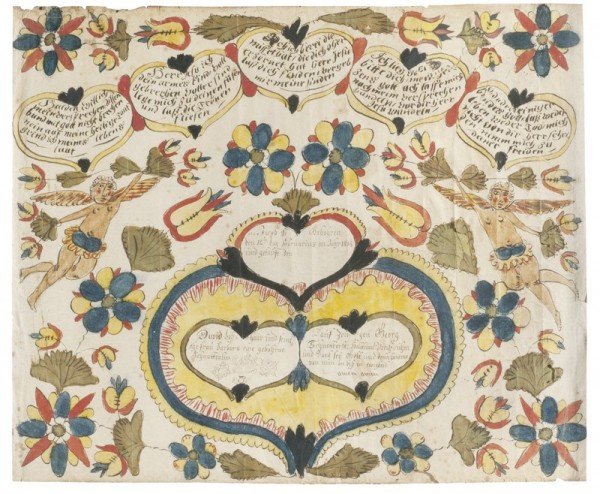
Birth and baptismal certificate for Jacob Boshaar, attributed to Joseph Lochbaum, Washington Township, Franklin County, Pennsylvania, ca. 1805. Watercolor and ink on laid paper. 13" x 15 1/2". (Courtesy, Philadelphia Museum of Art, promised gift of Joan and Victor Johnson; photo, Graydon Wood.)

Tall clock, movement attributed to Samuel Meyli, Lancaster County, Pennsylvania, ca. 1770. Walnut and sulfur inlay with tulip poplar; brass. H. 102", W. 20 1/2, D. 11 1/2". (Private Collection; photo, Gavin Ashworth.) The feet, finials and plinths, and valance are restored.
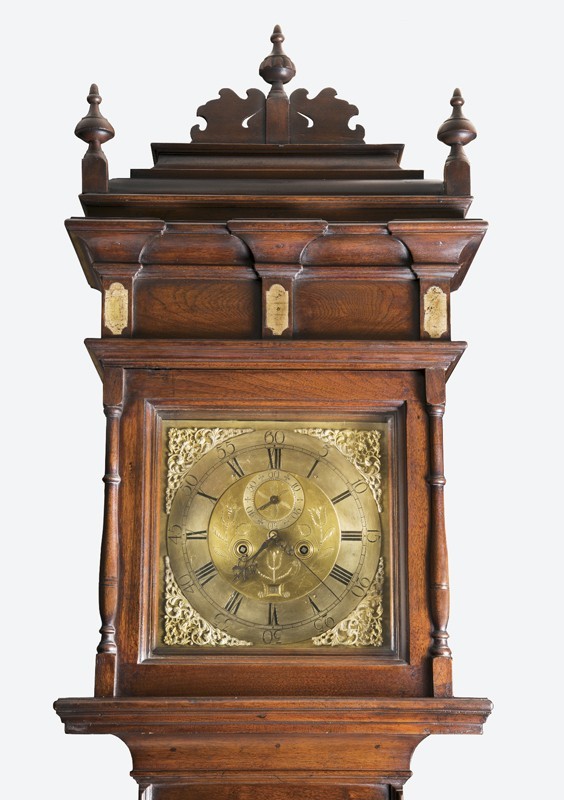
Hood of the clock illustrated in fig. 68. (Photo, Gavin Ashworth.)

Tall clock, movement signed by Benjamin Lamb of London, case made in Lancaster County, Pennsylvania, ca. 1765. Walnut with tulip poplar. H. 96 1/2", W. 22 1/8", D. 12 1/2". (Courtesy, Rock Ford Plantation, bequest of John J. Snyder Jr.; photo, Gavin Ashworth.)

Hood of the clock illustrated in fig. 70. (Photo, Gavin Ashworth.)
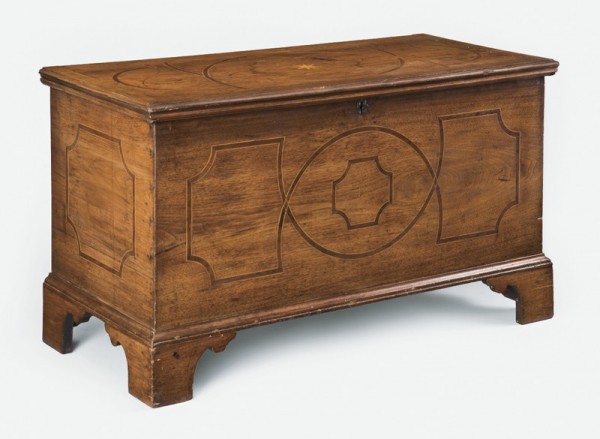
Chest, possibly made for Johannes Kilheffer, Lancaster County, Pennsylvania, ca. 1765. Walnut and mixed-wood inlay with white pine; iron, brass. H. 23", W. 42 1/2", D. 19 1/4". (Courtesy, Lancaster Mennonite Historical Society, bequest of John J. Snyder Jr.; photo, Gavin Ashworth.)

Lid of the chest illustrated in fig. 72. (Photo, Gavin Ashworth.)

Detail of the façade of the chest illustrated in fig. 72. (Photo, Gavin Ashworth.)
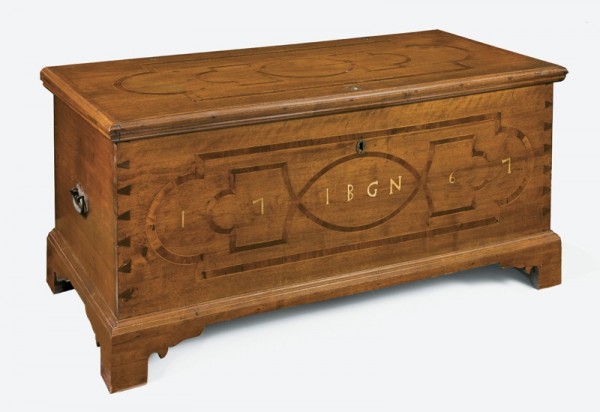
Chest, probably made for Jacob Gochnauer, Lancaster County, Pennsylvania, 1767. Walnut, mixed-wood inlay, and bone inlay; iron. H. 24 1/4", W. 50", D. 23 1/2". (Private collection; photo, Gavin Ashworth.)

Detail of the façade of the chest illustrated in fig. 75. (Photo, Gavin Ashworth.)

Chest, made for “EL S,” Pennsylvania, 1769. Walnut, pewter inlay, and sulfur inlay with pine and oak; iron, brass. H. 24 1/4", W. 53 3/4", D. 22 3/8". (Private collection; photo, Gavin Ashworth.)

Detail of a drawer from the chest illustrated in fig. 77. (Photo, Gavin Ashworth.)
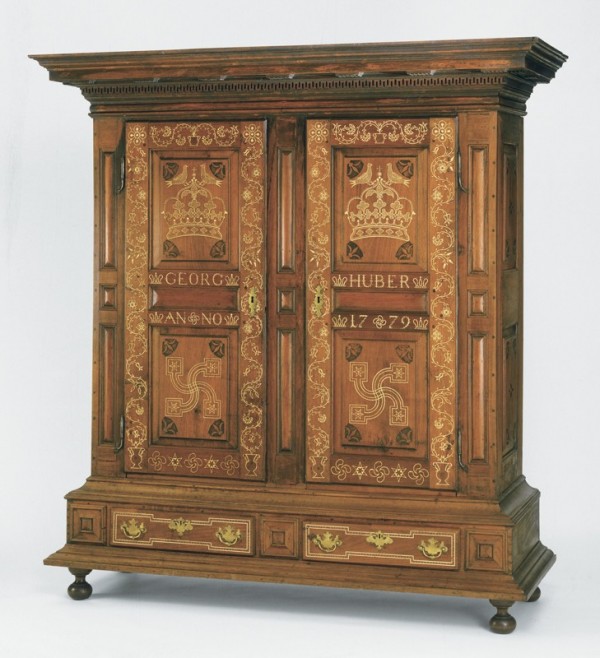
Schrank, made for Georg Huber, Lancaster County, Pennsylvania, 1779. Walnut and sulfur inlay with tulip poplar, pine, and oak; brass and iron. H. 83 1/8", W. 78", D. 27 1/2". (Courtesy, Philadelphia Museum of Art, 1957-30-1.) The feet are replaced.
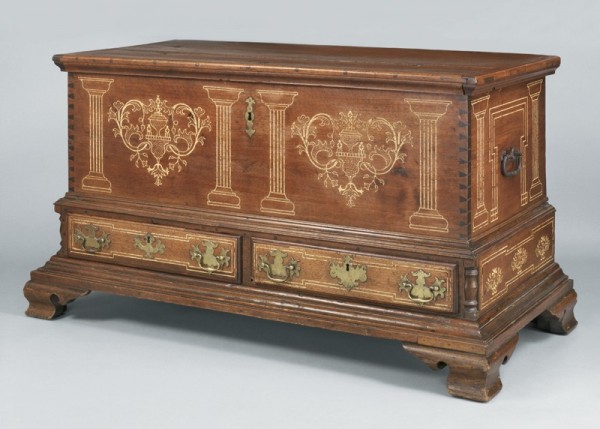
Chest, Lancaster County, Pennsylvania, 1783. Walnut and sulfur inlay with pine; brass, iron. H. 29 1/4", W. 54 1/2", D. 26 1/2". (Courtesy, National Museum of American History, Smithsonian Institution; photo, Winterthur Museum, Laszlo Bodo.) The feet are replaced.

End of the chest illustrated in fig. 80.

Till compartment of the chest illustrated in fig. 80.
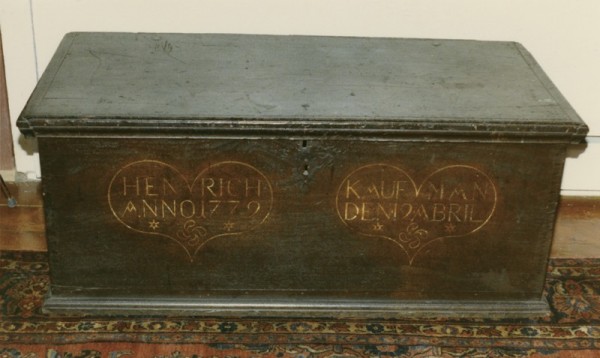
Chest, made for Henrich Kauffman, Lancaster County, Pennsylvania, 1779. Walnut and sulfur inlay. Dimensions unrecorded. (Photo, Steven F. Still Antiques.)

Chest, made for Barbara Lang, Manheim Township area, Lancaster County, Pennsylvania, 1782. Walnut and sulfur inlay with pine and tulip poplar; iron. H. 26 5/8", W. 52", D. 26 1/2". (Courtesy, Philadelphia Museum of Art, gift of Mr. and Mrs. Robert L. Raley, 1978-101-1; photo, Gavin Ashworth.)
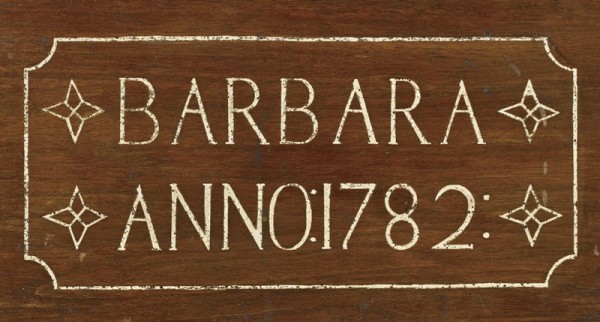
Detail of the inlay on the chest illustrated in fig. 84. (Photo, Gavin Ashworth.)

Detail of the inlay on the chest illustrated in fig. 84. (Photo, Gavin Ashworth.)

Chest, made for Maria Bachman, Manheim Township area, Lancaster County, Pennsylvania, 1784. Walnut and sulfur inlay with tulip poplar; iron, brass. H. 26 3/4", W. 52", D. 25 1/2". (Courtesy, Joan and Victor Johnson; photo, Gavin Ashworth.)
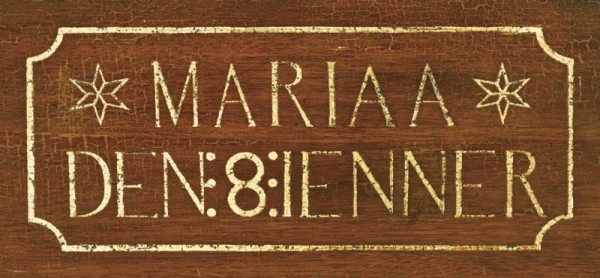
Detail of the inlay on the chest illustrated in fig. 87. (Photo, Gavin Ashworth.)

Detail of the inlay on the chest illustrated in fig. 87. (Photo, Gavin Ashworth.)

Detail of the inlay on a chest, Lancaster County, Pennsylvania, 1784. Walnut and sulfur inlay. (Courtesy, Winterthur Museum; photo, James Schneck.)
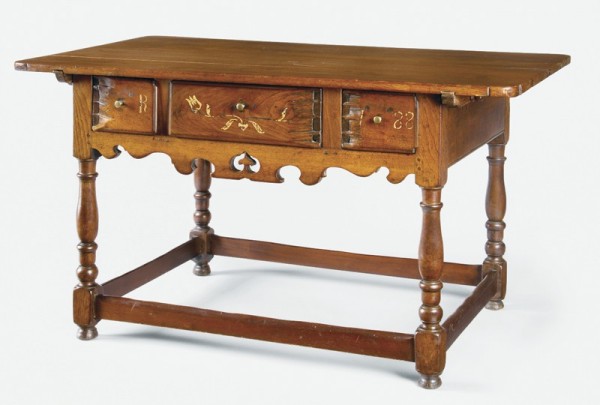
Table, made for “I R,” Lancaster County, Pennsylvania, 1788. Walnut and sulfur inlay with white pine; brass. H. 28 5/8", W. 52 3/4", D. 31". (Courtesy, Chester County Historical Society; photo, Gavin Ashworth.) The stretchers are replaced.

Detail of the inlay on the table illustrated in fig. 91. (Photo, Gavin Ashworth.)

Tall clock, movement by George Hoff, Lancaster County, Pennsylvania, 1790. Walnut and sulfur inlay with tulip poplar, pine, and oak. H. 89 1/2", W. 20 1/2", D. 16". (Courtesy, Joan and Victor Johnson; photo, Winterthur Museum, Laszlo Bodo.)
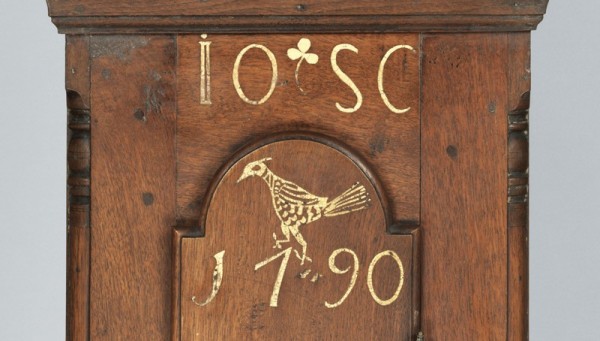
Detail of the inlay on the clock illustrated in fig. 93.

Miniature chest, made for “BA RI,” Lancaster County, Pennsylvania, 1799. Walnut and sulfur inlay with tulip poplar; iron. H. 8 1/2", W. 17 3/4", D. 9 1/2". (Courtesy, Kelly Kinzle Antiques; photo, Gavin Ashworth.)
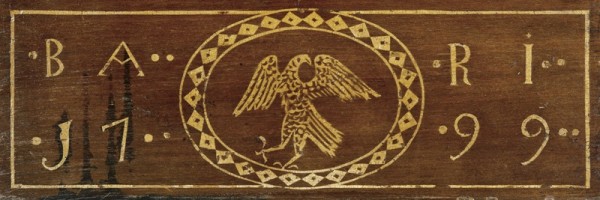
Detail of the inlay on the chest illustrated in fig. 95. (Photo, Gavin Ashworth.)

Straightedge, Lancaster County, Pennsylvania, 1800. Walnut and sulfur inlay. H. 1 7/8", W. 22 1/2", D.1/4". (Courtesy, Stephen and Dolores Smith; photo, Winterthur Museum, Laszlo Bodo.)
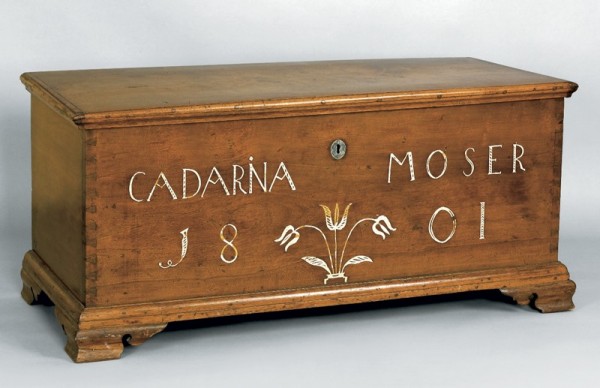
Chest, made for Cadarina Moser, Lancaster County, Pennsylvania, 1801. Walnut and sulfur inlay with white pine; iron. H. 23", W. 48 1/4", D. 20". (Photo, Pook & Pook.)
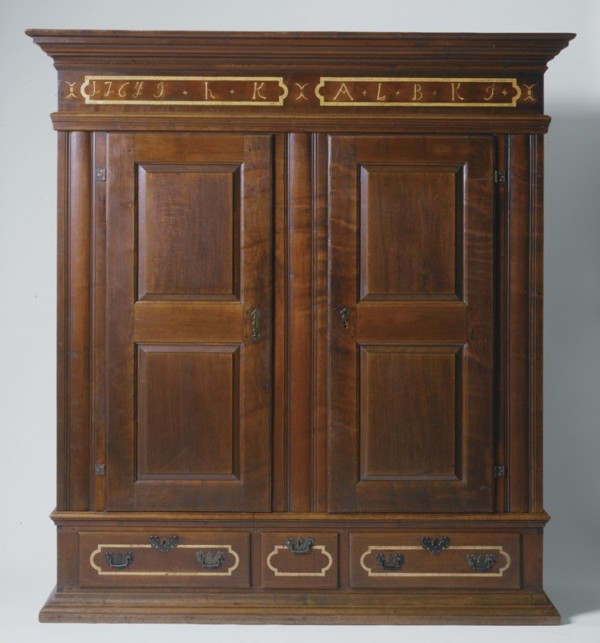
Schrank, probably made for Johannes and Anna Elisabeth Kauffman, East Hempfield Township, Lancaster County, Pennsylvania, 1764. Walnut and sulfur inlay with tulip poplar and oak; brass, iron. H. 80 1/2", W. 73 3/4", D. 35". (Private collection; photo, Philip H. Bradley Co.)
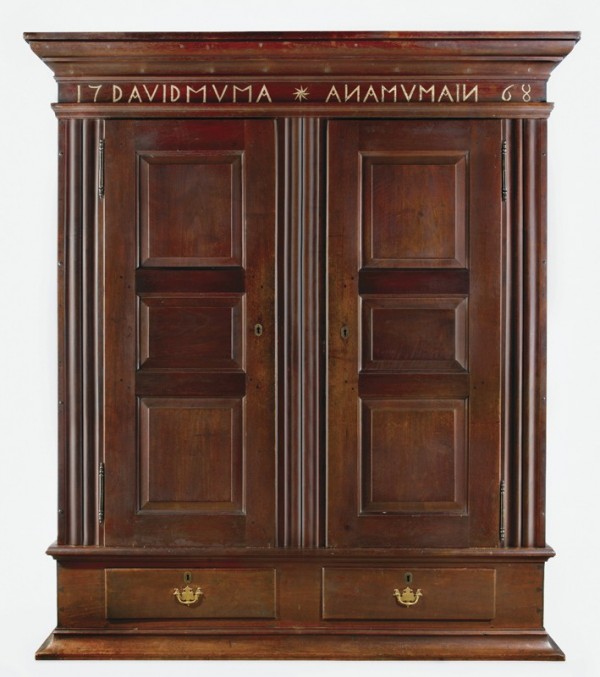
Schrank, made for David and Anna Mumma, West Hempfield Township, Lancaster County, Pennsylvania, 1768. Walnut and sulfur inlay; iron, brass. H. 84 1/2", W. 74 1/2", D. 27 1/4". (Courtesy, Lancaster Mennonite Historical Society, bequest of John J. Snyder Jr.; photo, Gavin Ashworth.)

Tall clock, probably Lancaster County, Pennsylvania, 1767. Walnut, sulfur inlay, and mixed-wood inlay with tulip poplar. H. 89 1/8", W. 19 3/4", D. 10 3/4". (Courtesy, Barnes Foundation, Philadelphia, 01.24.25.)

Hood of the clock illustrated in fig. 101.
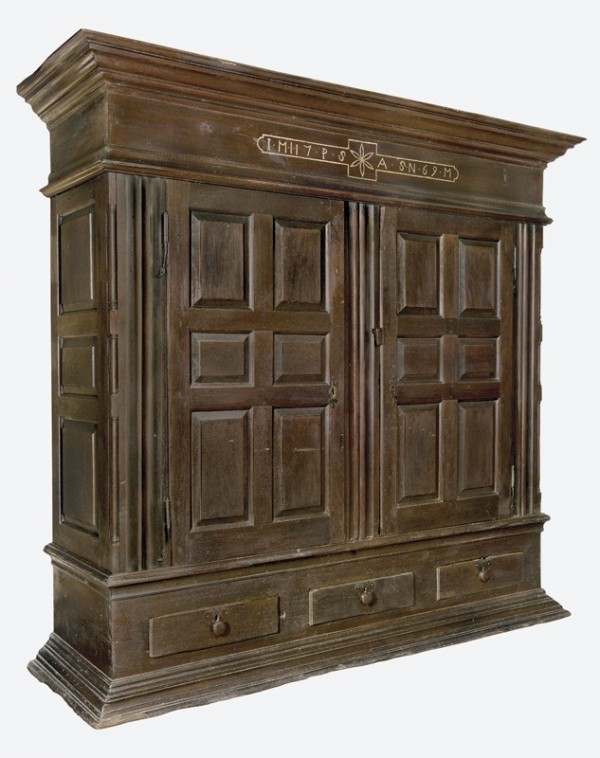
Schrank, probably made for Peter and Ada Schwar, Lancaster County, Pennsylvania, 1769. Walnut and sulfur inlay with tulip poplar and white pine; iron, brass. H. 82", W. 87", D. 27 1/2". (Courtesy, Clarke Hess; photo, Gavin Ashworth.) The five ball feet are missing.

Detail of the inlay on the schrank illustrated in fig. 103. (Photo, Gavin Ashworth.)

Cradle, possibly made for Anna (Schwar) Shenk, Lancaster County, Pennsylvania, 1770. Walnut and sulfur inlay with tulip poplar. H. 28", W. 30", D. 38". (Courtesy, Clarke Hess; photo, Gavin Ashworth.) One of the pillow panels is missing.

Detail of the inlay on the headboard of the cradle illustrated in fig. 105. (Photo, Gavin Ashworth.)

Miniature chest, made for Andreas Bartruff, Manheim, Lancaster County, Pennsylvania, ca. 1775. Walnut and sulfur inlay with tulip poplar; iron. H. 7 5/8", W. 16 1/8", D. 8 5/8". (Private collection; photo, Gavin Ashworth.)
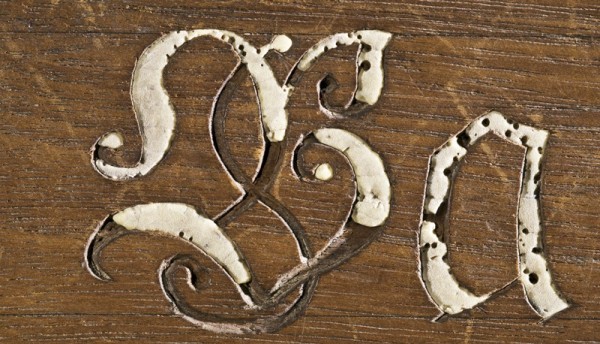
Detail of the inlay on the chest illustrated in fig. 107. (Photo, Gavin Ashworth.)
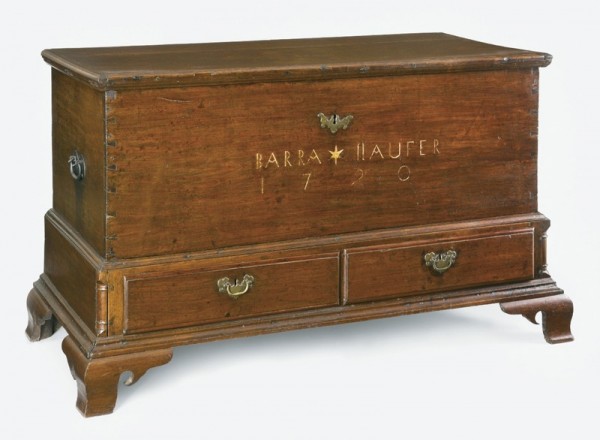
Chest, made for Barbara Stauffer, Lancaster County, Pennsylvania, 1790. Walnut and sulfur inlay with white pine; iron, brass. H. 30 1/2", W. 52 1/2", D. 24 1/2". (Courtesy, Salvatore A. Rizzuto; photo, Gavin Ashworth.) The feet are replaced.
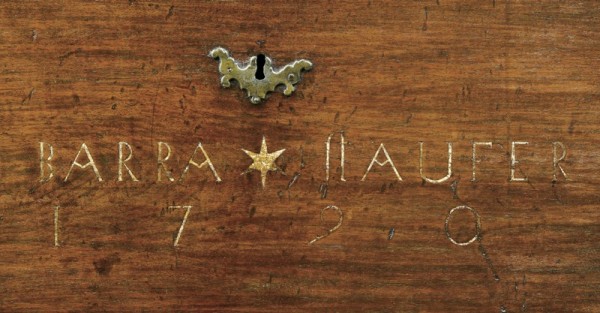
Detail of the inlay on the chest illustrated in fig. 109. (Photo, Gavin Ashworth.)

Schrank, made for Michael and Eva Magdalena Ley, probably made by Christoph Uhler, Lebanon, Lancaster (now Lebanon) County, Pennsylvania, 1771. Walnut and sulfur inlay with tulip poplar and white pine; brass. H. 99 1/4", W. 91", D. 26". (Courtesy, Rocky Hill Collection; photo, Winterthur Museum, Laszlo Bodo.)
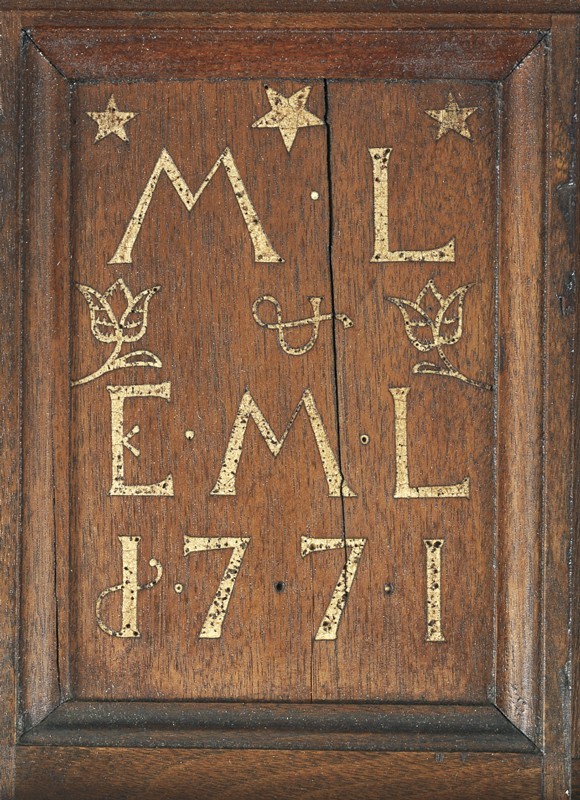
Detail of the inlay on the schrank illustrated in fig. 111.

Schrank, probably made by Christoph Uhler (1741–1804), Lebanon, Lancaster (now Lebanon) County, Pennsylvania, 1771. Walnut and sulfur inlay with pine and tulip poplar; iron, brass. H. 91 1/2", W. 86 1/2", D. 26". (Private collection; photo, Gavin Ashworth.)
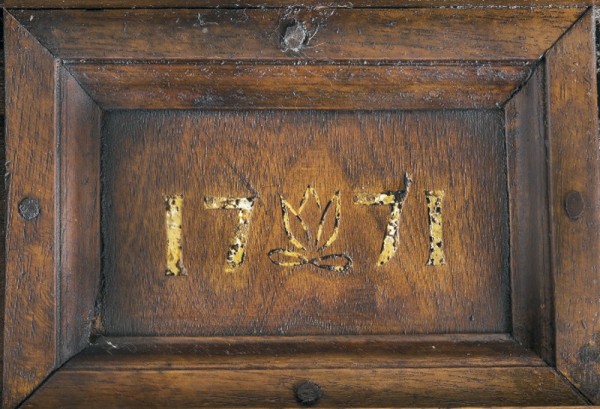
Detail of the inlay on the schrank illustrated in fig. 113. (Photo, Gavin Ashworth.)
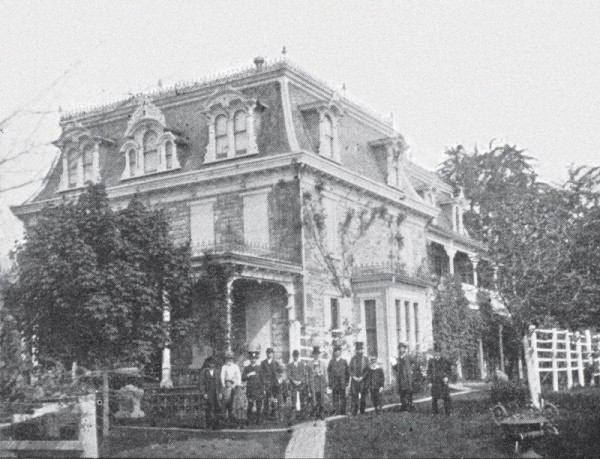
Tulpehocken Manor, built for Michael and Eva Magdalena Ley, Lebanon County, Pennsylvania, 1769, remodeled 1883, photo ca. 1885. (From Rev. P.C. Croll, Ancient and Historic Landmarks in the Lebanon Valley [Philadelphia: Lutheran Publication Society, 1895].)

Door pediment from Tulpehocken Manor, signed by Christoph Uhler, Lebanon, Lancaster (now Lebanon) County, 1769. White pine; paint. H. 21 3/4", W. 70 1/4", D. 3 3/4". (Courtesy, James C. Keener; photo, Winterthur Museum, Laszlo Bodo.)
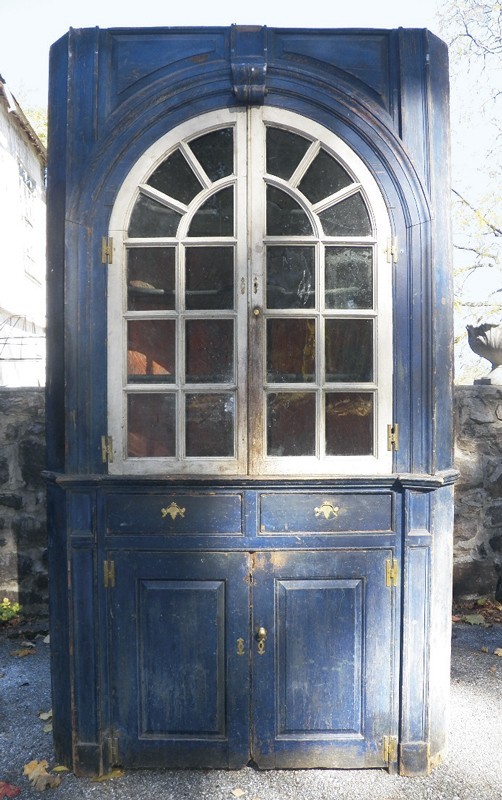
Corner cupboard from Tulpehocken Manor, probably made by Christoph Uhler, Lebanon, Lancaster (now Lebanon) County, ca. 1769. Pine and tulip poplar; paint; glass. H. 101", W. 57", D. 40". (Courtesy, Greg K. Kramer and Co.)
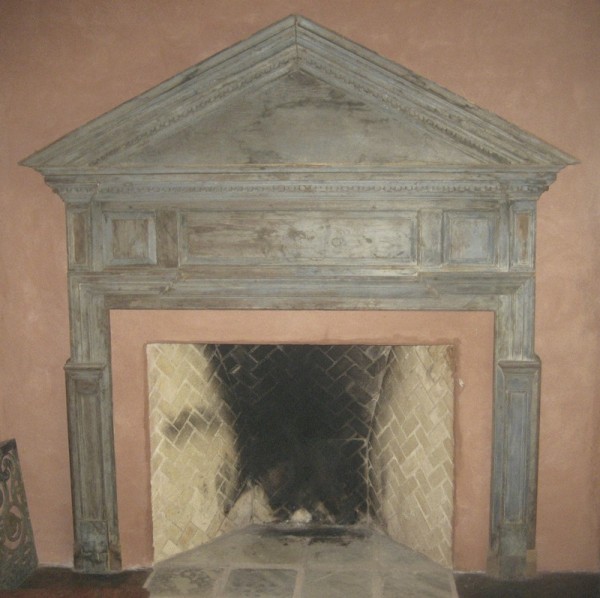
Fireplace surround from Tulpehocken Manor, probably made by Christoph Uhler, Lebanon, Lancaster (now Lebanon) County, ca. 1769. (Courtesy, Lynda and Richard Levengood; photo, Lisa Minardi.)

Tall clock, probably made for Henry Eshleman, movement signed by John Heinselman, Manheim, Lancaster County, Pennsylvania, 1795. Walnut and sulfur inlay with tulip poplar. H. 86", W. 18 1/4", D. 10 1/4". (Courtesy, Rock Ford Plantation, bequest of John J. Snyder Jr.; photo, Gavin Ashworth.)

Detail of the inlay on the clock illustrated in fig. 119. (Photo, Gavin Ashworth.)
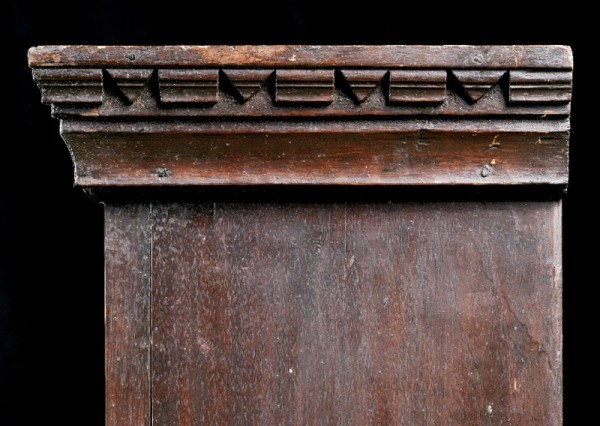
Detail of the cornice on the clock illustrated in fig. 119. (Photo, Gavin Ashworth.)
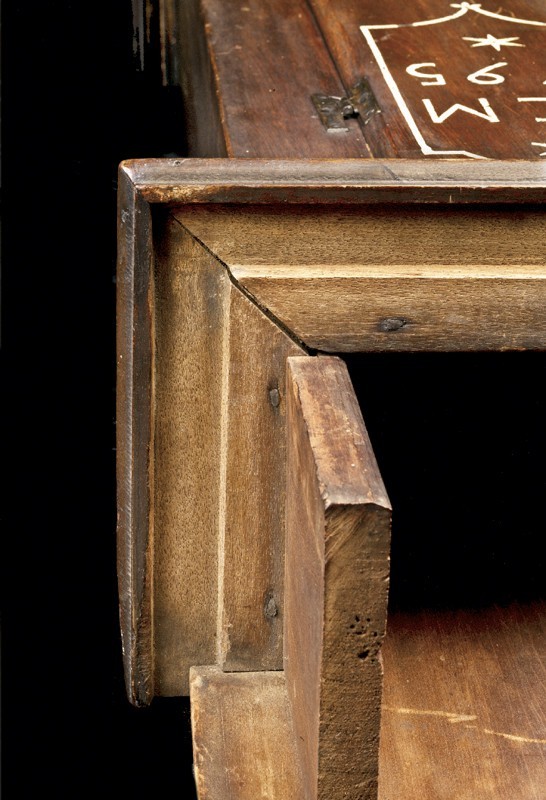
Detail of the groove for the hood on the clock illustrated in fig. 119. (Photo, Gavin Ashworth.)

Tall clock, made for “H h,” movement signed by Christian Forrer, Lampeter, Lancaster County, Pennsylvania, 1766. Walnut and sulfur inlay. H. 89 3/4", W. 21," D. 11 3/4". (Courtesy, Ed and Mary Ann Dixon; photo, Gavin Ashworth.)

Detail of the inlay on the clock illustrated in fig. 123. (Photo, Gavin Ashworth.)

Tall clock, probably made for Michael Horst, movement signed by George Hoff, Lancaster, Lancaster County, Pennsylvania, 1785. Walnut and sulfur inlay with white pine. H. 84 3/4", W. 22," D. 12". (Courtesy, Clarke Hess; photo, Gavin Ashworth.) The base has been shortened.

Tall clock, made for “A M,” probably Lancaster County, Pennsylvania, 1795. Walnut and sulfur inlay with tulip poplar; brass. H. 87", W. 20 1/2," D. 10 3/4". (Courtesy, Carl and Yvonne De Paulis; photo, Gavin Ashworth.)

Detail of the inlay on the tall clock illustrated in fig. 126. (Photo, Gavin Ashworth.)

Chest, probably made for Jacob Ebersole, probably Lancaster County, Pennsylvania, 1785. Walnut and sulfur inlay; iron, brass. H. 28", W. 52", D. 25". (Courtesy, Leslie Miller and Richard Worley; photo, Gavin Ashworth.)
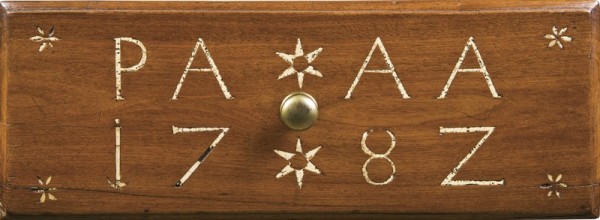
Drawer from a table, made for “PA AA,” probably Lancaster County, Pennsylvania, 1782. Walnut and sulfur inlay. Dimensions unrecorded. (Private collection; photo, Gavin Ashworth.)
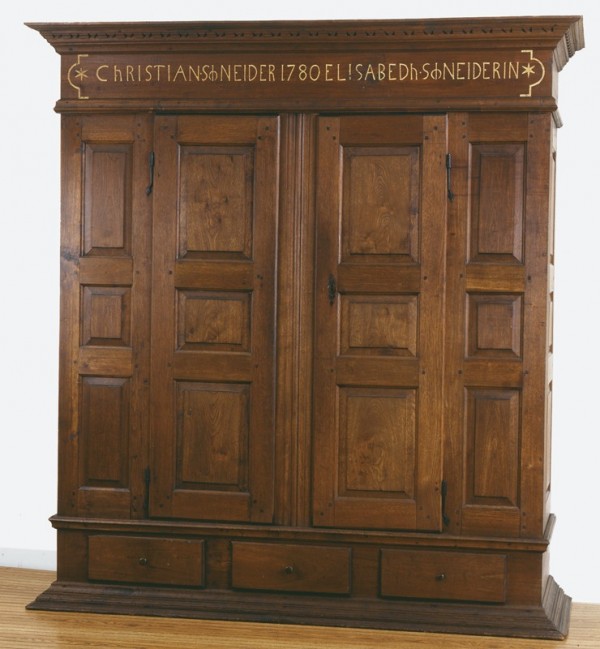
Schrank, made for Christian and Elisabeth Schneider, probably Lancaster County, Pennsylvania, 1780. Walnut and sulfur inlay; iron. H. 80 1/2", W. 74", D. 24 1/4". (Private collection; photo, Joseph Schneider Haus.)

Frieze of a schrank, made for John and Mary Mennig/Minnich, probably Lancaster County, Pennsylvania, 1789. Walnut and sulfur inlay. H. 8 3/4", W. 68 3/4", D. 1". (Courtesy, David A. Schorsch; photo, Gavin Ashworth.)

Cradle, made for “EV MI,” probably Lancaster County, Pennsylvania, 1789. Walnut and sulfur inlay. H. 22 3/4", W. 28 1/8", D. 38 3/8". (Courtesy, Winterthur Museum, promised gift of David A. Schorsch and Eileen M. Smiles; photo, James Schneck.)
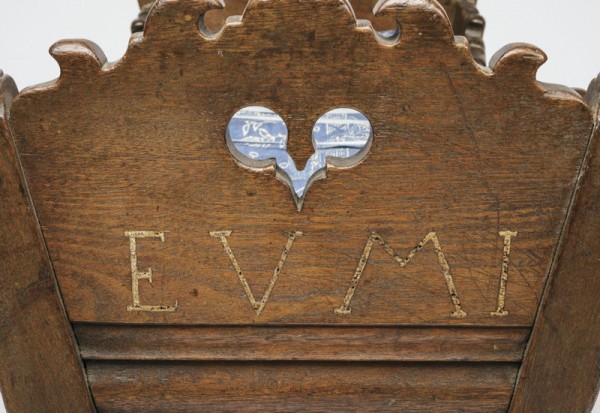
Detail of the inlay on headboard of the cradle illustrated in fig. 132.
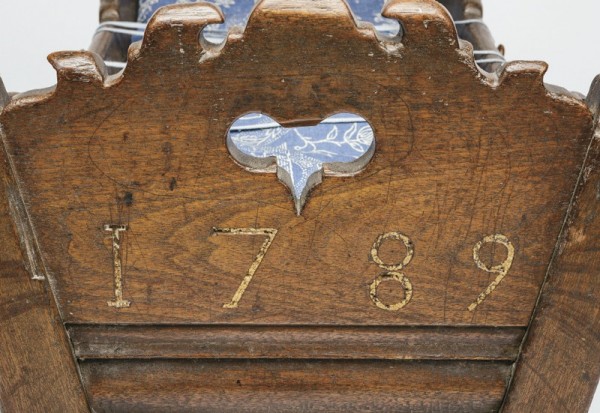
Detail of the inlay on the footboard of the cradle illustrated in fig. 132.
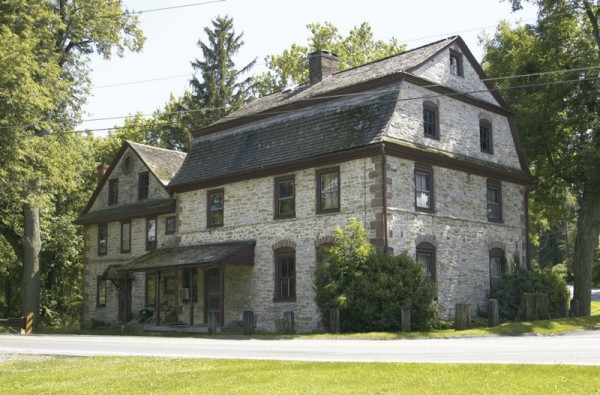
House of George and Maria Catharina Miller, Millbach, Lebanon County, Pennsylvania, 1752. (Courtesy, Millbach Foundation; photo, Winterthur Museum, Laszlo Bodo.)
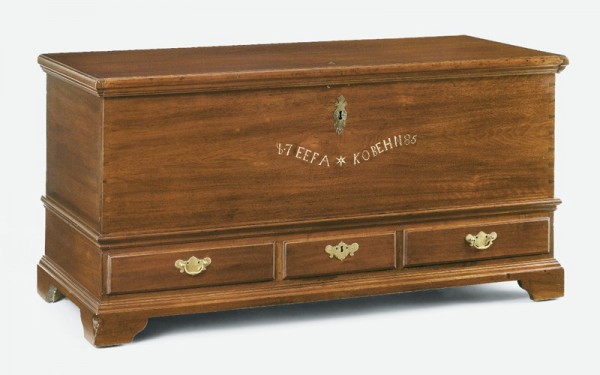
Chest, probably made for Eva Koppenhefer, Lebanon County, Pennsylvania, 1785. Walnut and sulfur inlay with white pine and tulip poplar; iron, brass. H. 28 1/2", W. 54 7/8", D. 24 3/8". (Courtesy, Philip H. Bradley Co.; photo, Gavin Ashworth.)

Detail of the inlay on the chest illustrated in fig. 136. (Photo, Gavin Ashworth.)
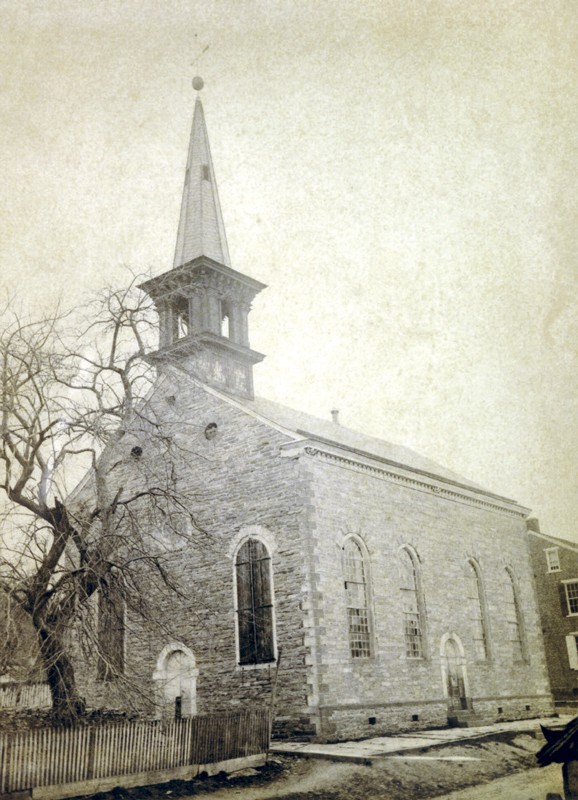
Christ Lutheran Church, near Stouchsburg, Marion Township, Berks County, Pennsylvania, built in 1786. (Courtesy, Mr. and Mrs. Michael Emery.)
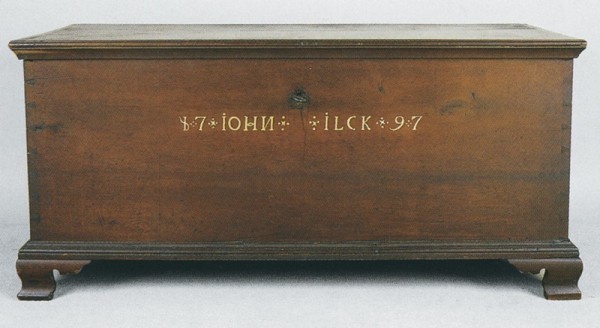
Chest, made for John Illig, Lebanon County, Pennsylvania, 1797. Walnut and sulfur inlay. H. 25", W. 52 1/2", D. 23". (Private collection; photo, Conestoga Auction Co.)

Detail of a door lintel, probably Middletown, Dauphin County, Pennsylvania, 1764. Pine. H. 9", W. 40 1/2", D. 5 1/4". (Courtesy, Pennsylvania Historical and Museum Commission, State Museum of Pennsylvania.)
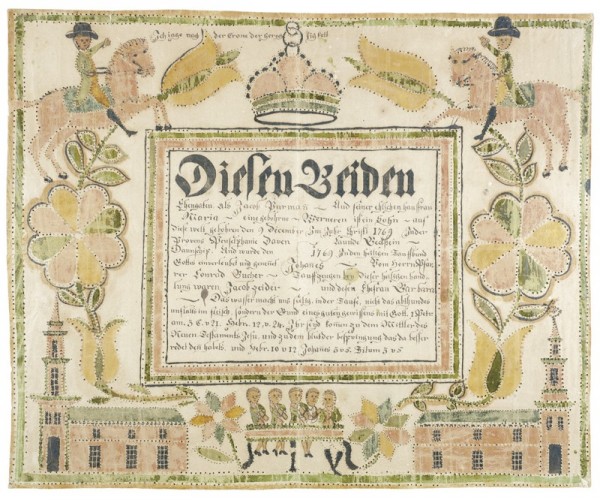
Birth and baptismal certificate, made for Johannes Poorman, Paxton Township, Dauphin County, Pennsylvania, ca. 1785. Watercolor and ink on laid paper. 12 1/2" x 15 1/2". (Courtesy, Susan and Stephen Babinsky; photo, Winterthur Museum, James Schneck.)
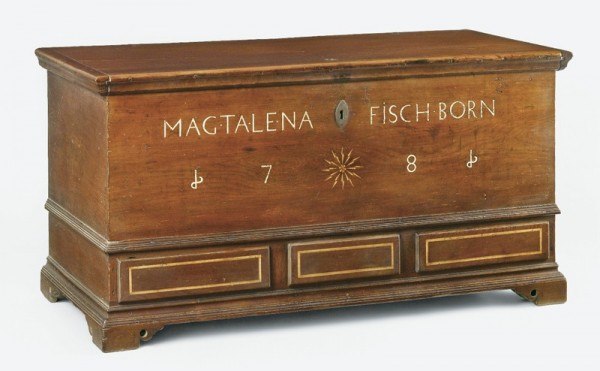
Chest, made for Magdalena Fischborn, Dauphin County, Pennsylvania, 1781. Walnut, sulfur inlay, and mixed-wood inlay with pine; iron. H. 27 1/2", W. 52 3/4", D. 24 1/4". (Courtesy, Carl and Yvonne De Paulis; photo, Gavin Ashworth.)
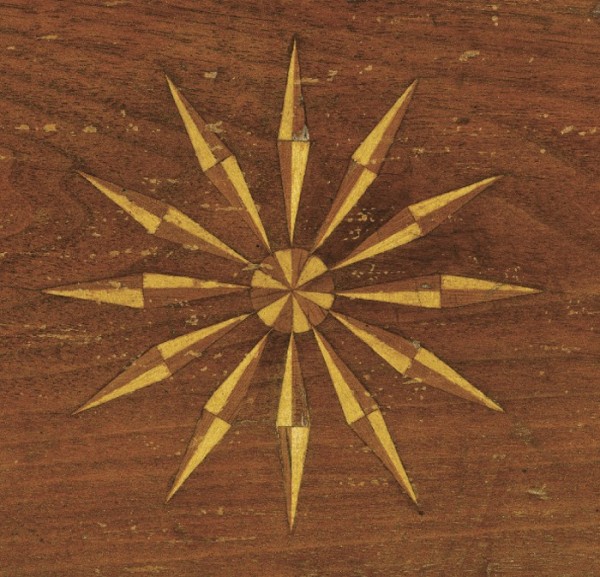
Detail of the inlaid star on the chest illustrated in fig. 142. (Photo, Gavin Ashworth.)
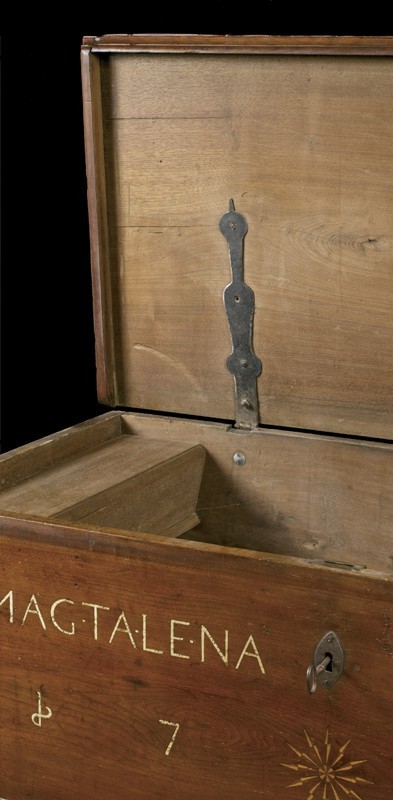
Detail of the till compartment of the chest illustrated in fig. 142. (Photo, Gavin Ashworth.)
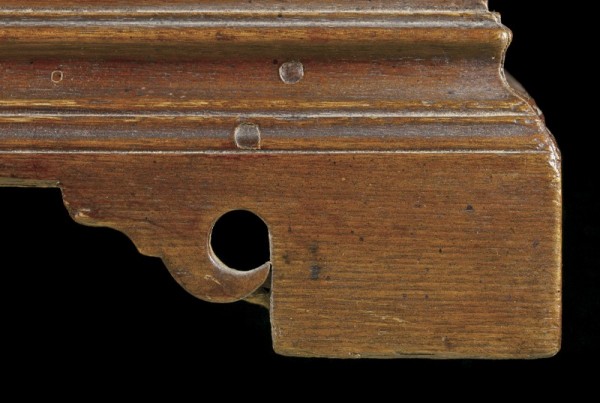
Detail of the bracket foot of the chest illustrated in fig. 142. (Photo, Gavin Ashworth.)
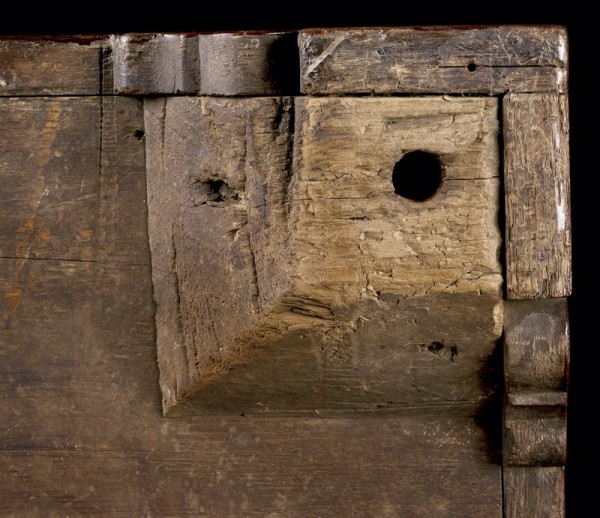
Detail of the glue block of the chest illustrated in fig. 142. (Photo, Gavin Ashworth.)

Façade of a chest, made for Ludwig Brandt, Dauphin County, Pennsylvania, 1769. Walnut with sulfur inlay; iron. H. 18 3/8", W. 51 3/4", D. 1". (Courtesy, Edward and Linda Rosenberry; photo, Winterthur Museum, James Schneck.)
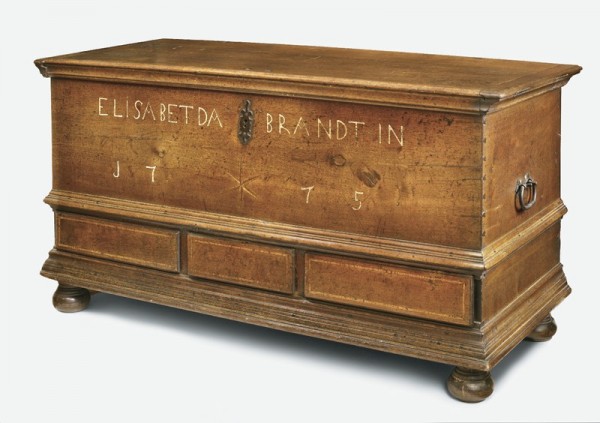
Chest, made for Elisabetha Brandt, Dauphin County, Pennsylvania, 1775. Walnut with sulfur and wood inlay and white pine and tulip poplar; iron. H. 30 1/2", W. 58 3/4", D. 25 3/4". (Courtesy, Renfrew Museum; photo, Gavin Ashworth.)
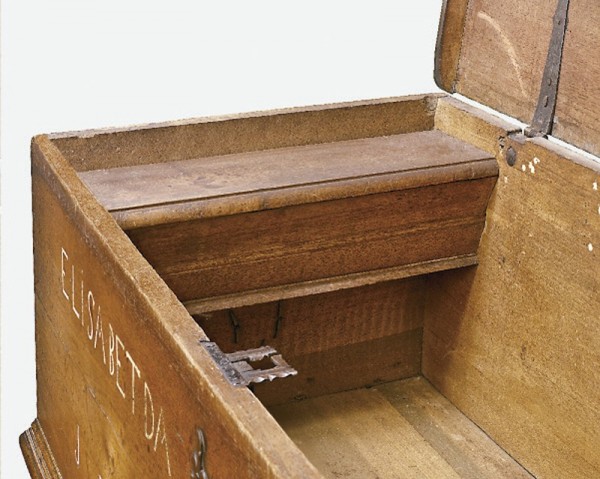
Detail of the till compartment of the chest illustrated in fig. 148. (Photo, Gavin Ashworth.)

Detail of the hidden drawers of the chest illustrated in fig. 148. (Photo, Gavin Ashworth.)
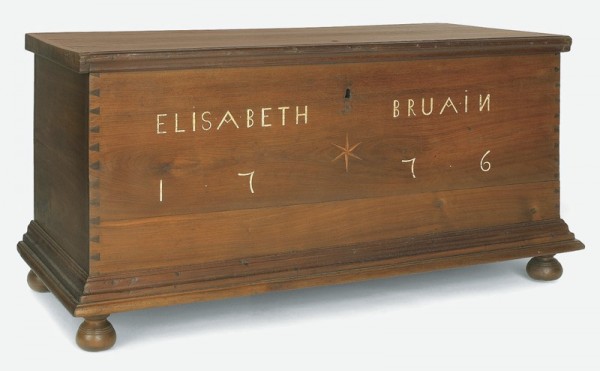
Chest, made for Elisabeth Brua, Dauphin County, Pennsylvania, 1776. Walnut, sulfur inlay, and wood inlay with tulip poplar; iron. H. 26", W. 49 1/2", D. 24". (Courtesy, Pook & Pook.)
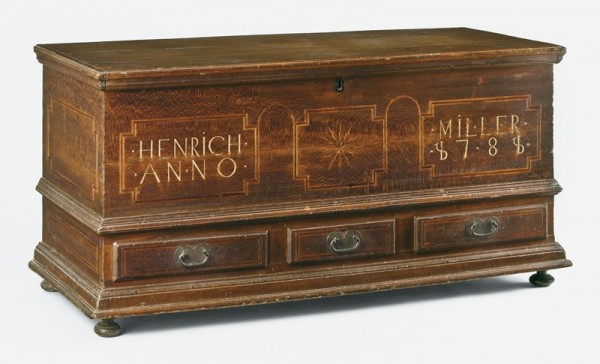
Chest, made for Henrich Miller, Dauphin County, Pennsylvania, 1781. Sycamore, sulfur inlay, and mixed-wood inlay with tulip poplar; iron, brass. H. 27 3/4", W. 54 1/4", D. 24". (Courtesy, Rocky Hill Collection; photo, Gavin Ashworth.)
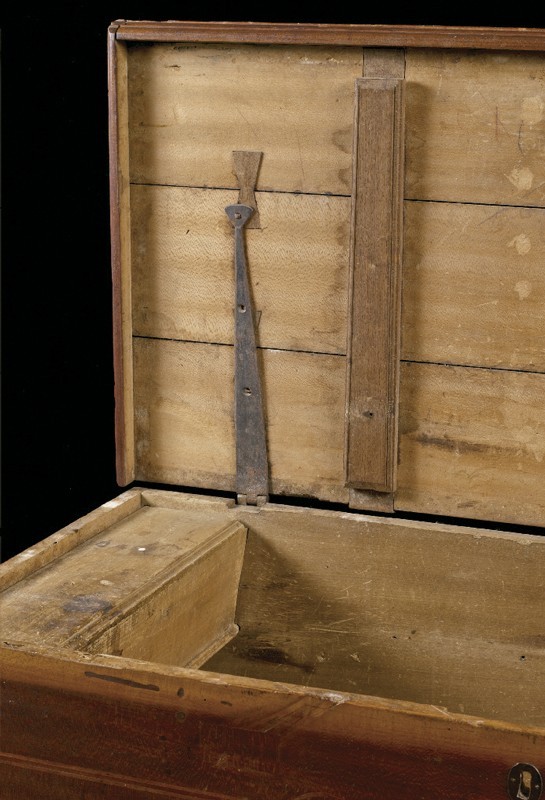
Interior of the chest illustrated in fig. 152. (Photo, Gavin Ashworth.) The maker used a sliding batten to stabilize the three-board lid and installed a slanted till compartment.
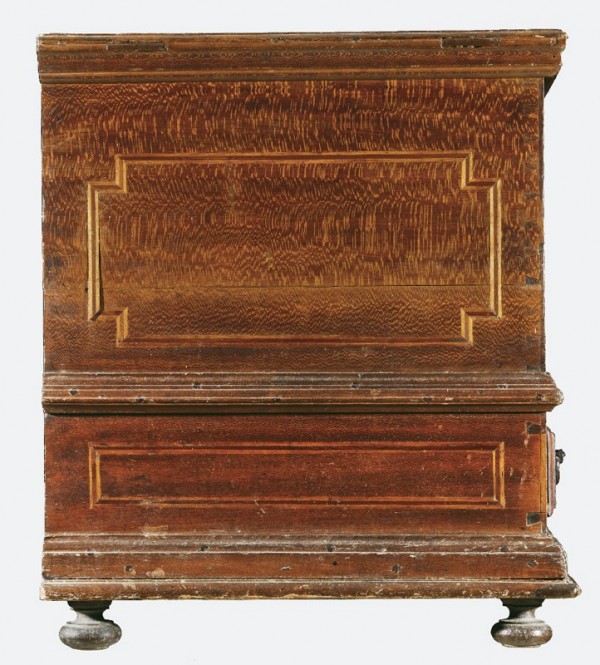
Side of the chest illustrated in fig. 152. (Photo, Gavin Ashworth.)
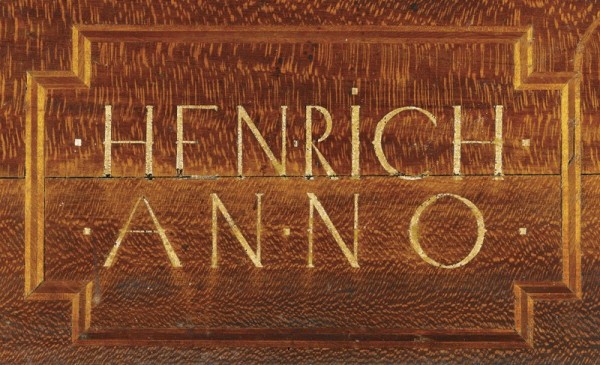
Detail of the inlay on the façade of the chest illustrated in fig. 152. (Photo, Gavin Ashworth.)
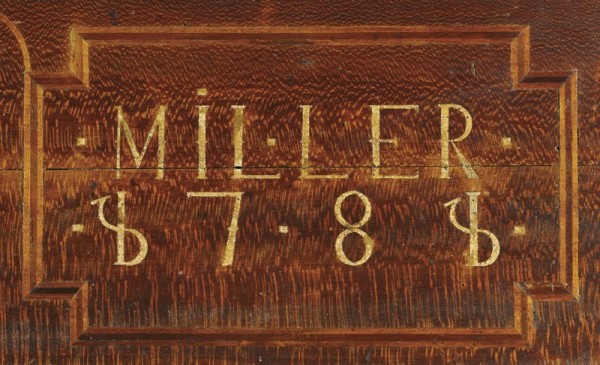
Detail of the inlay on the façade of the chest illustrated in fig. 152. (Photo, Gavin Ashworth.)

Chest, made for Lutwig Fischborn, Dauphin County, Pennsylvania, 1783. Walnut, sulfur inlay, and mixed-wood inlay with tulip poplar; brass, iron. H. 27 1/2", W. 51 1/2", D. 23 3/4". (Courtesy, Carl and Yvonne De Paulis; photo, Gavin Ashworth.)

Detail of the inlay on the chest illustrated in fig. 157. (Photo, Gavin Ashworth.)

Chest, made for Maria Klinger, Dauphin County, Pennsylvania, 1792. Walnut, sulfur inlay, and mixed-wood inlay with tulip poplar and white pine; brass, iron. H. 27", W. 51 1/2", D. 24". (Courtesy, Rock Ford Plantation, bequest of John J. Snyder Jr.; photo, Gavin Ashworth.)
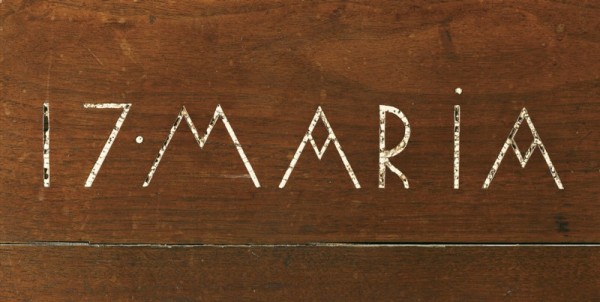
Detail of the inlay on the chest illustrated in fig. 159. (Photo, Gavin Ashworth.)
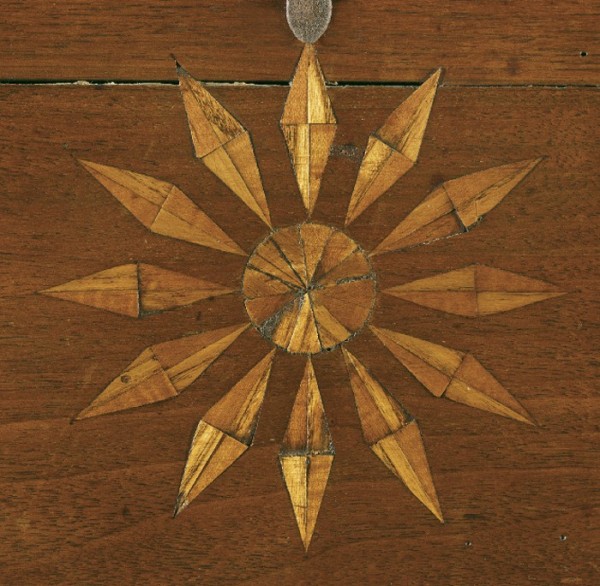
Detail of the inlay on the chest illustrated in fig. 159. (Photo, Gavin Ashworth.)

Chest, made for “CH KM,” probably Dauphin County, Pennsylvania, 1788. Walnut and mixed-wood inlay with tulip poplar; brass, iron. H. 26", W. 54", D. 23". (Courtesy, Clarke Hess; photo, Gavin Ashworth.)
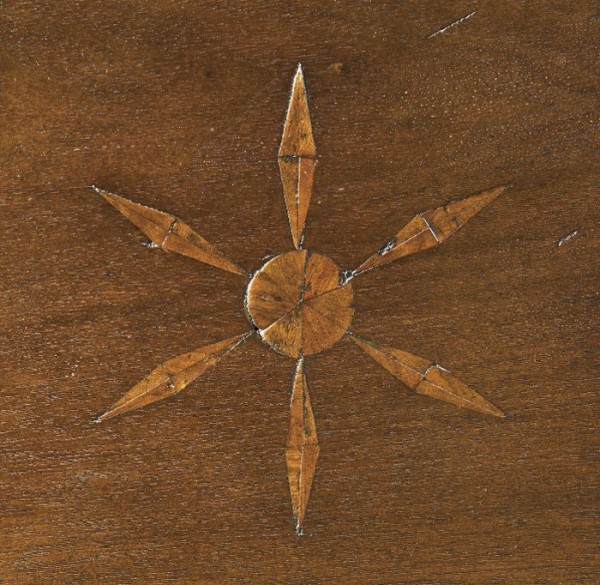
Detail of the star inlay on the chest illustrated in fig. 162. (Photo, Gavin Ashworth.)

Chest, made for “ML,” probably Dauphin County, Pennsylvania, 1789. Walnut, sulfur inlay, and mixed-wood inlay with tulip poplar; brass, iron. H. 27 1/8", W. 50", D. 23 3/4". (Courtesy, Mr. and Mrs. Stephen D. Hench; photo, Gavin Ashworth.)
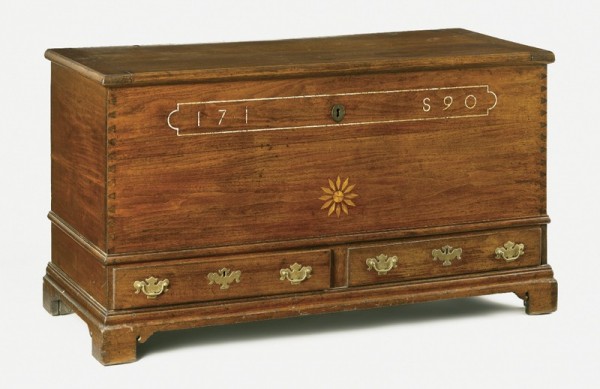
Chest, made for “IS,” Dauphin County, Pennsylvania, 1790. Walnut and sulfur inlay with tulip poplar; brass, iron. H. 27 1/2", W. 49 1/2", D. 23". (Courtesy, Winterthur Museum, bequest of John J. Snyder Jr.; photo, Gavin Ashworth.)
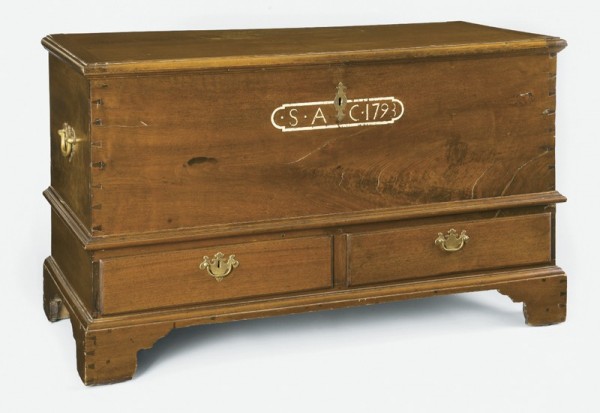
Chest, made for “S A C,” probably Dauphin County, Pennsylvania, 1793. Walnut and sulfur inlay with tulip poplar; brass, iron. H. 29 5/8", W. 50 1/2", D. 23 3/4". (Courtesy, Pennsylvania Historical and Museum Commission, Landis Valley Village and Farm Museum, bequest of John J. Snyder Jr.; photo, Gavin Ashworth.)
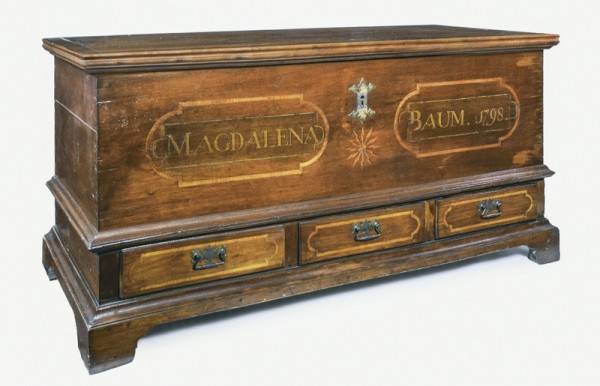
Chest, made for Magdalena Baum, probably Dauphin County, Pennsylvania, 1798. Walnut and mixed-wood inlay with white pine and tulip poplar; brass, iron; paint. H. 27", W. 55 1/2", D. 23". (Courtesy, Historical Society of Dauphin County, Harrisburg, Pa.; photo, David Pickel.)

Detail of the inlay and paint on the chest illustrated in fig. 167.
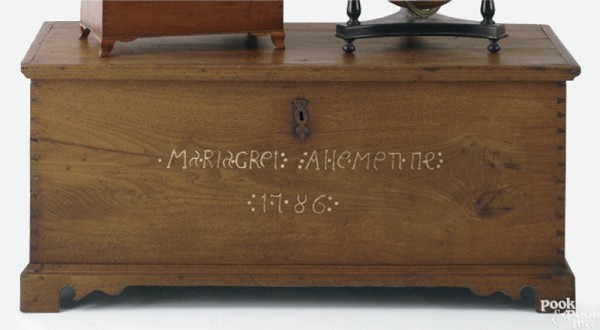
Chest, made for Margaret Alleman, Dauphin County, Pennsylvania, 1786. Walnut and sulfur inlay; iron. H. 22", W. 48", D. 24". (Photo, Pook & Pook.)
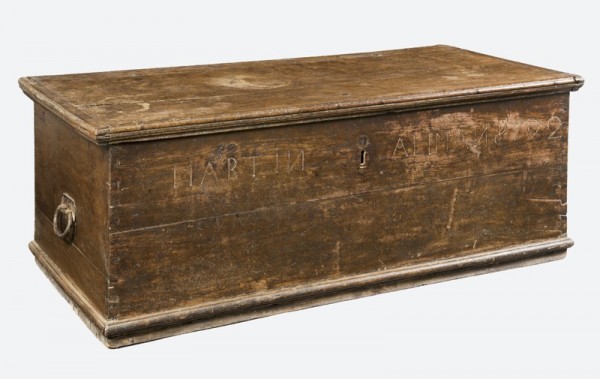
Chest, made for Martin Alleman, Dauphin County, Pennsylvania, 1792. Walnut and sulfur inlay with white pine, tulip poplar; iron. H. 20 1/2", W. 52", D. 24 1/4". (Courtesy, Clarke Hess; photo, Gavin Ashworth.) The chest was originally over drawers and has been reduced in height.

Detail of the inlay on the chest illustrated in fig. 170. (Photo, Gavin Ashworth.)

William Wagner, view of York, York County, Pennsylvania, 1830. (Courtesy, York County Heritage Trust, York, Pa.)

Tall clock, made for “A G and AMG,” movement signed by John Fisher, York, York County, Pennsylvania, 1773. Walnut and sulfur inlay. H. 99", W. 17 1/2", D. 11 1/2". (Private collection; photo, Winterthur Library, Decorative Arts Photographic Collection.)
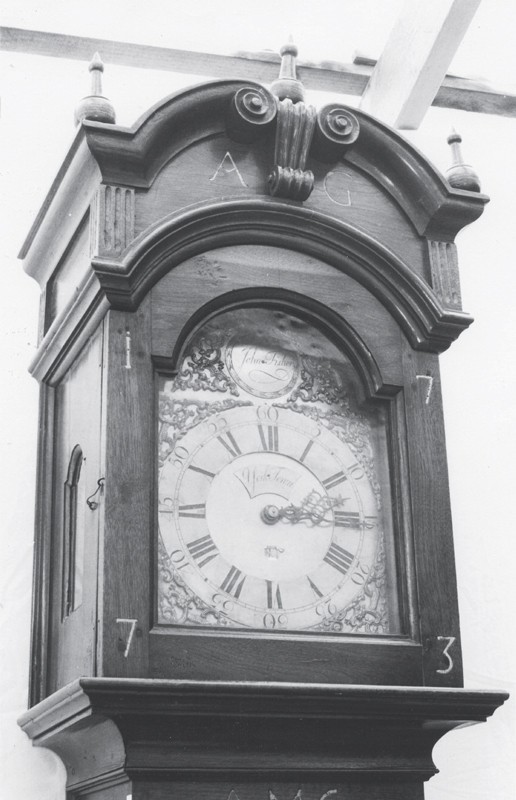
Detail of the clock illustrated in fig. 173.
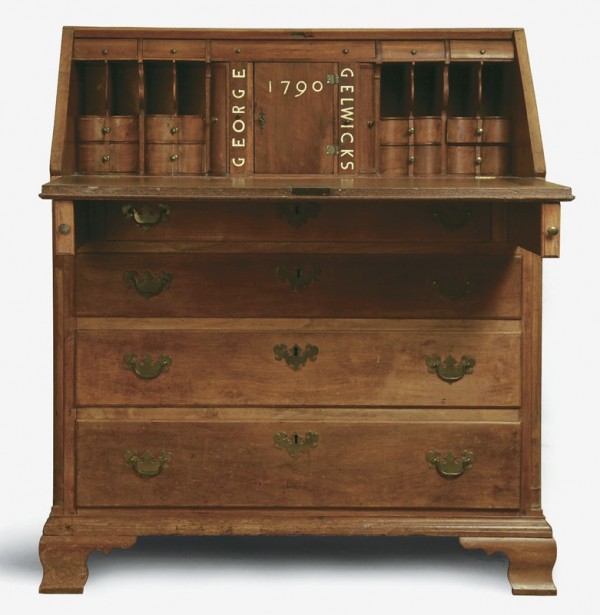
Desk, made for George Gelwicks, York County, Pennsylvania, 1790. Walnut with sulfur inlay and pine. H. 44 1/4", W. 41 1/4", D. 22". (Private collection; photo, Rob Manko.)

Detail of the inlay on the desk illustrated in fig. 175.
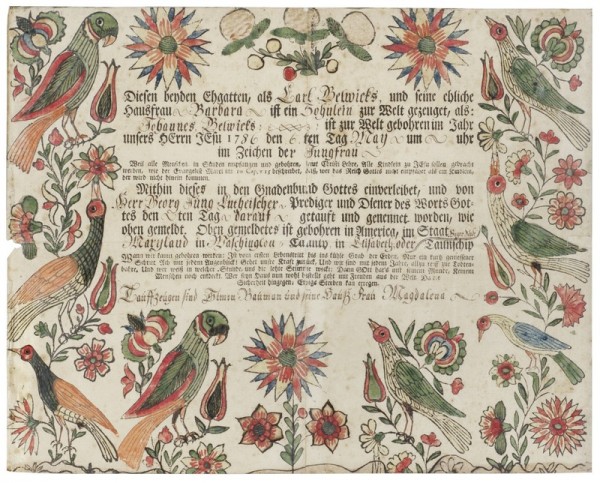
Birth and baptismal certificate for Johannes Gelwicks, decoration and infill attributed to the Pseudo-Otto Artist, printed form attributed to the Ephrata Cloister, Lancaster County, Pennsylvania, ca. 1788. Watercolor and ink on laid paper. 13" x 16". (Courtesy, Philadelphia Museum of Art, promised gift of Joan and Victor Johnson; photo, Graydon Wood.)

Chest of drawers, made for Casper Renaker, York County, Pennsylvania, ca. 1790. Walnut and sulfur inlay with pine and tulip poplar. H. 51 1/2", W. 41 1/4", D. 22". (Courtesy, Carl and Yvonne De Paulis; photo, Gavin Ashworth.) The feet, top, and knobs are replaced.
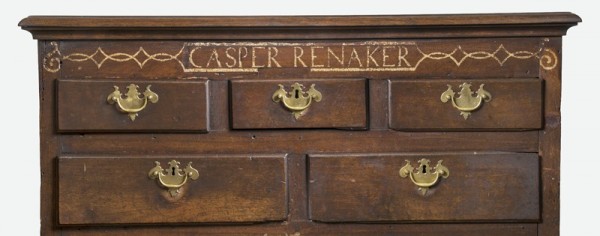
Detail of the inlay on the chest of drawers illustrated in fig. 178. (Photo, Gavin Ashworth.)
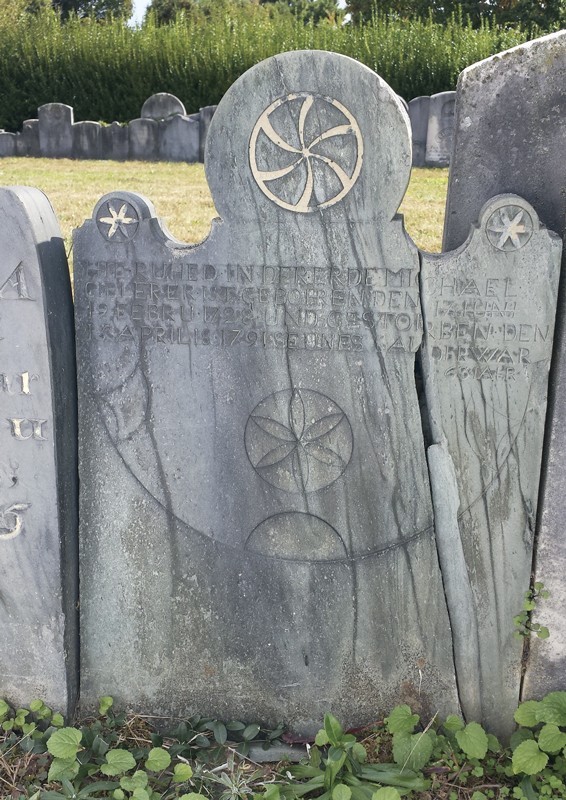
Tombstone for Michael Gibler, St. Mary’s Church, Carroll County, Maryland, 1791. (Photo, Lisa Minardi.)
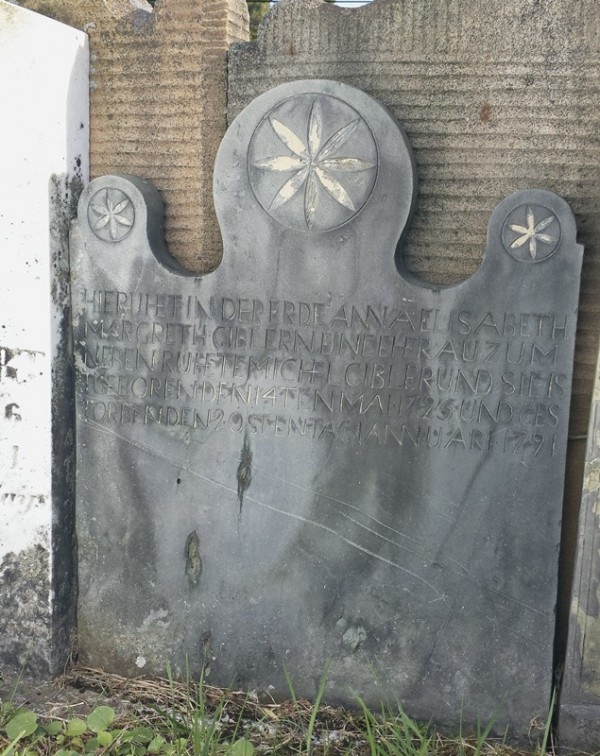
Tombstone for Anna Elisabeth Margreth Gibler, St. Mary’s Church, Carroll County, Maryland, 1791. (Photo, Lisa Minardi.)

Tombstone for Paul Renecker, St. Mary’s Church, Carroll County, Maryland, 1799. (Photo, Lisa Minardi.)
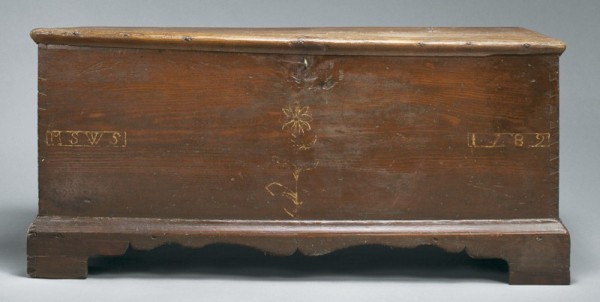
Chest, probably York County, Pennsylvania, 1789. Yellow pine; paint; iron. H. 22 1/2", W. 49", D. 21 1/2". (Courtesy, Museum of the Shenandoah Valley, Winchester, Va.; photo, Ron Blunt.) The left foot is restored. It is also possible that this chest was made in Shenandoah County, Virginia.
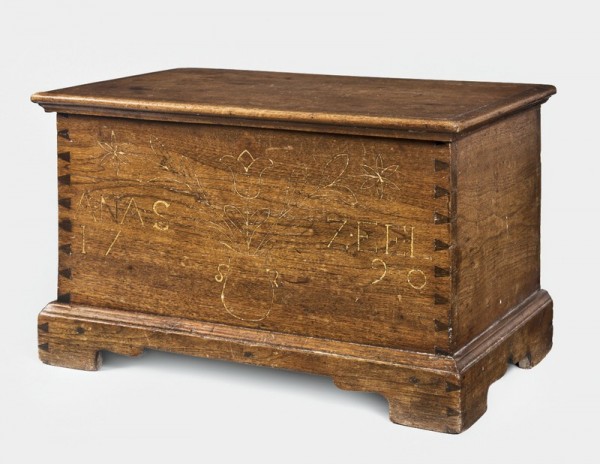
Miniature chest, probably made for Anna Sell/Zell, York County, Pennsylvania, 1790. Walnut and sulfur inlay with pine. H. 11 3/8", W. 19 1/4", D. 11 1/2". (Private collection; photo, Gavin Ashworth.)
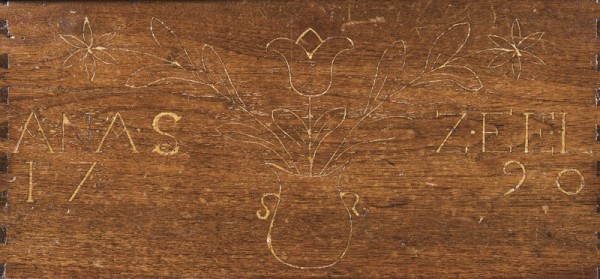
Detail of the inlay on the chest illustrated in fig. 184. (Photo, Gavin Ashworth.)

Chest, probably made for Peter Holtzappel, York County, Pennsylvania, 1791. Walnut and sulfur inlay with pine; paint. H. 24 1/2", W. 49", D. 20 1/4". (Courtesy, Clarke Hess; photo, Gavin Ashworth.) The feet and base molding are replaced.
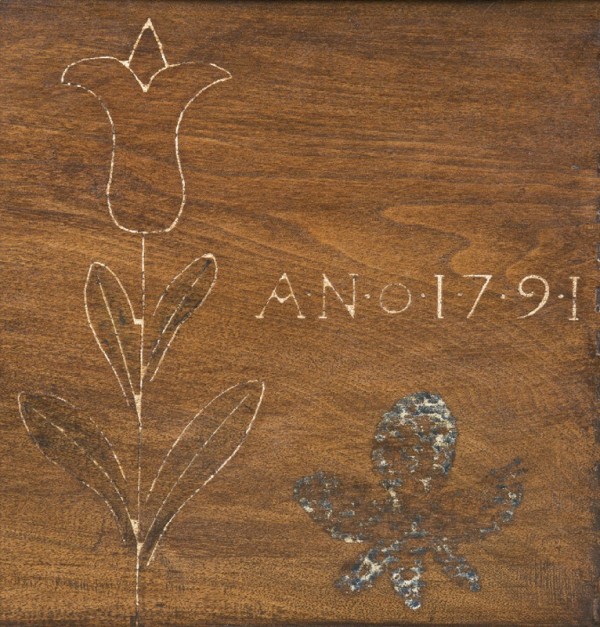
Detail of the inlay on the chest illustrated in fig. 186. (Photo, Gavin Ashworth.)

Tall clock, southeastern Pennsylvania, 1766. Walnut, sulfur inlay, and mixed-wood inlay; secondary woods unrecorded. H. 88", W. 19", D. 10 1/2". (Location unknown; photo, Christie’s.)
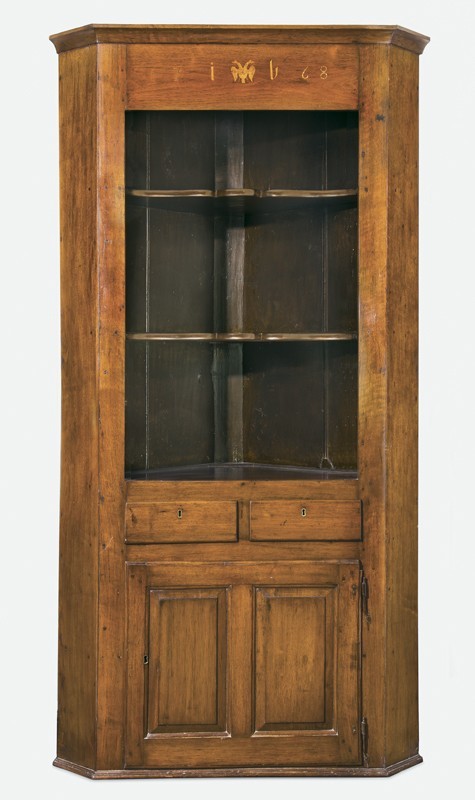
Corner cupboard, southeastern Pennsylvania, 1768. Walnut, sulfur inlay, and mixed-wood inlay with tulip poplar and pine; iron, brass. H. 85 1/2", W. 47", D. 22 1/2". (Courtesy, Renfrew Museum; photo, Gavin Ashworth.) The upper door is missing.

Detail of the inlay on the cupboard illustrated in fig. 189. (Photo, Gavin Ashworth.)
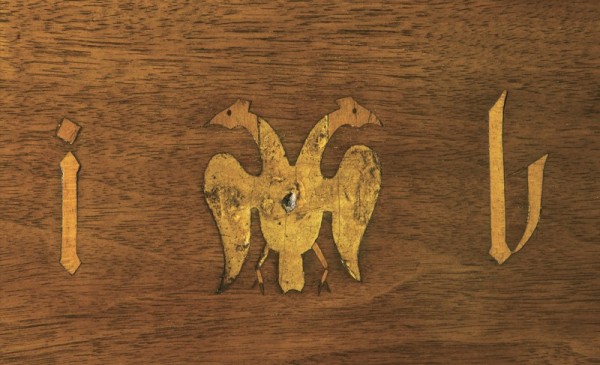
Detail of the inlay on the cupboard illustrated in fig. 189. (Photo, Gavin Ashworth.)

Chest, made for Veronica Miller, southeastern Pennsylvania, 1785. Walnut and sulfur inlay with tulip poplar; iron, brass. H. 20", W. 52", D. 23 3/4". (Courtesy, Clarke Hess; photo, Gavin Ashworth.) The feet and base molding are replaced; the chest used to be over two drawers.
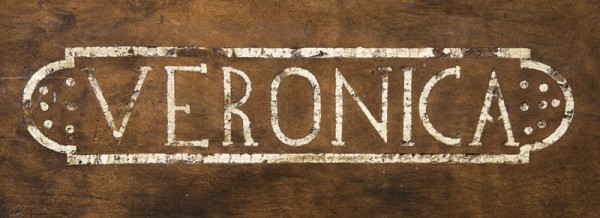
Detail of the inlay on the chest illustrated in fig. 192. (Photo, Gavin Ashworth.)

Detail of the inlay on the chest illustrated in fig. 192. (Photo, Gavin Ashworth.)
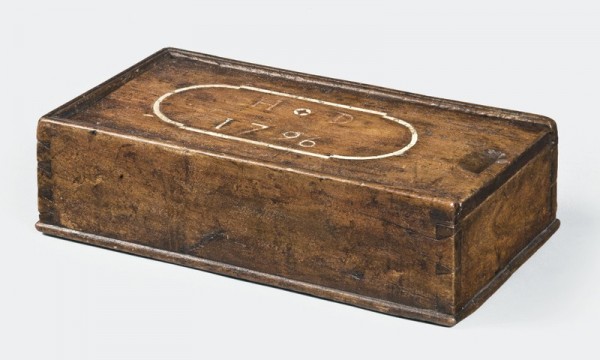
Slide-lid box, made for “H D,” probably Lancaster County, Pennsylvania, 1796. Walnut and sulfur inlay. H. 3 1/4", W. 6 5/8", D. 12". (Private collection; photo, Gavin Ashworth.)
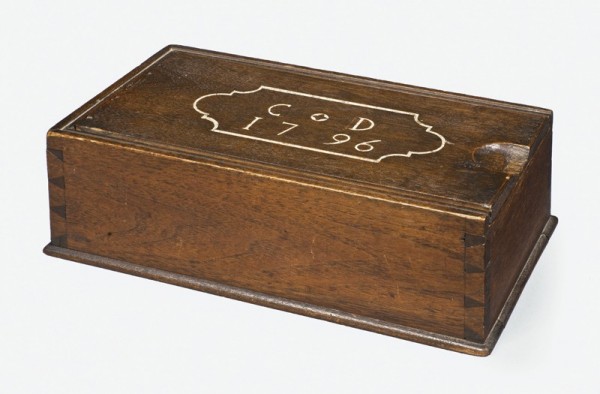
Slide-lid box, made for “C D”, probably Lancaster County, Pennsylvania, 1796. Walnut and sulfur inlay. H. 4 3/8", W. 8", D. 13 3/8". (Private collection; photo, Gavin Ashworth.)

Slide-lid box, made for “M D,” probably Lancaster County, Pennsylvania, 1797. Walnut and sulfur inlay. H. 4 3/8", W. 8", D. 13 3/8". (Courtesy, Mr. and Mrs. Stephen D. Hench; photo, Gavin Ashworth.)
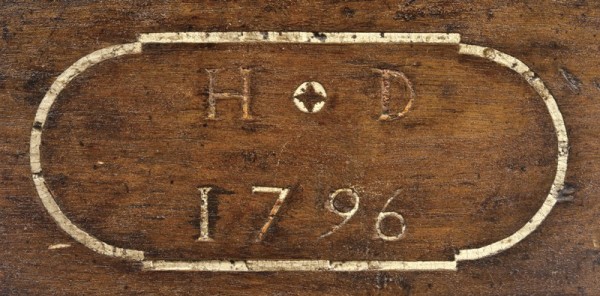
Detail of the inlay on the lid of the box illustrated in fig 195. (Photo, Gavin Ashworth.)

Detail of the inlay on the lid of the box illustrated in fig 196. (Photo, Gavin Ashworth.)
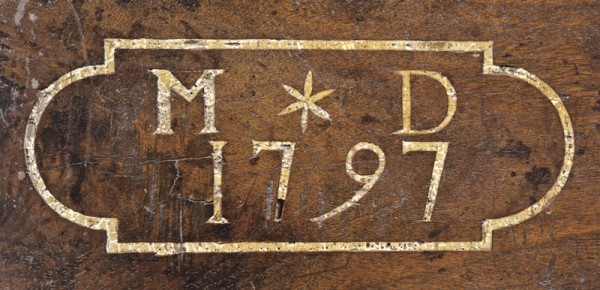
Detail of the inlay on the lid of the box illustrated in fig 197. (Photo, Gavin Ashworth.)

Chest, made for “HA BE,” possibly Lancaster County, Pennsylvania, 1768. Walnut and sulfur inlay with walnut and oak; brass, iron. H. 27 5/8", W. 48 3/4", D. 22 1/4". (Private collection; photo, Gavin Ashworth.) The feet are replaced.
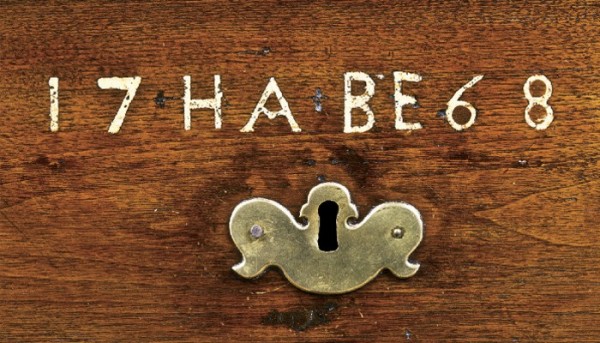
Detail of the inlay on the chest illustrated in fig. 201. (Photo, Gavin Ashworth.)
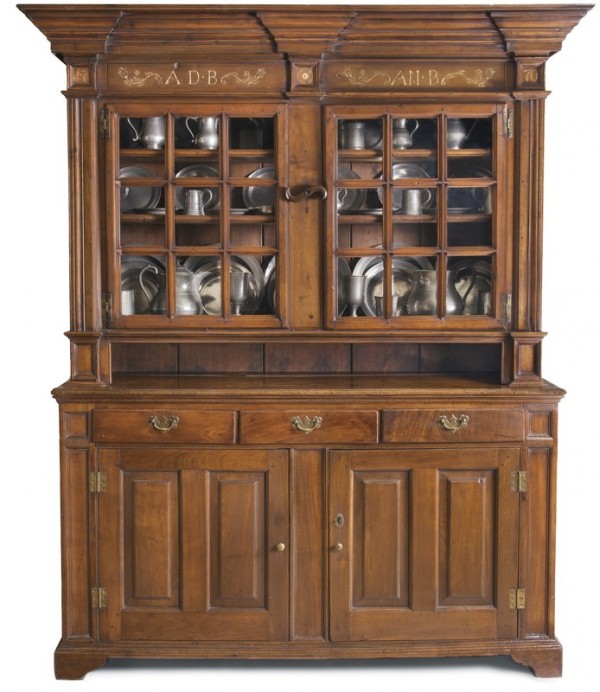
Kitchen cupboard, possibly made for Adam and Anna Brandt, Lebanon County, Pennsylvania, 1770. Walnut and sulfur inlay with pine and tulip poplar; brass, iron. H. 89 1/2", W. 76 /2", D. 20 3/4". (Courtesy, Rocky Hill Collection; photo, Gavin Ashworth.) The pie shelf section and brasses are restored.
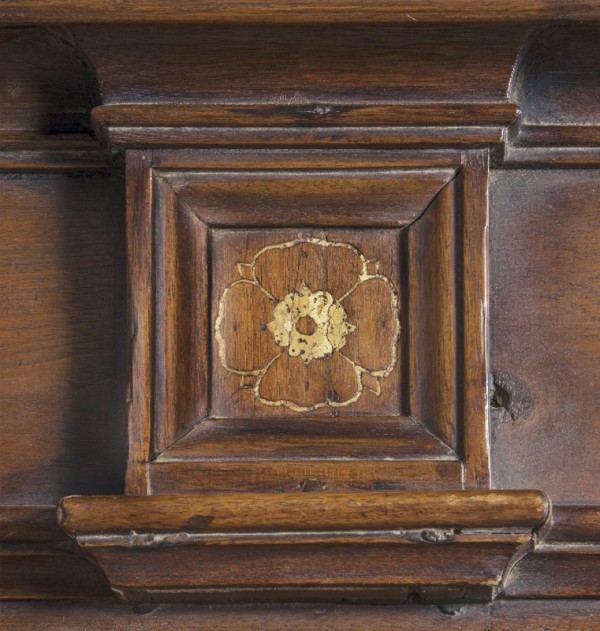
Detail of the inlay on the cupboard illustrated in fig. 203. (Photo, Gavin Ashworth.)

Detail of the inlay on the cupboard illustrated in fig. 203. (Photo, Gavin Ashworth.)

Detail of the inlay on the cupboard illustrated in fig. 203. (Photo, Gavin Ashworth.)
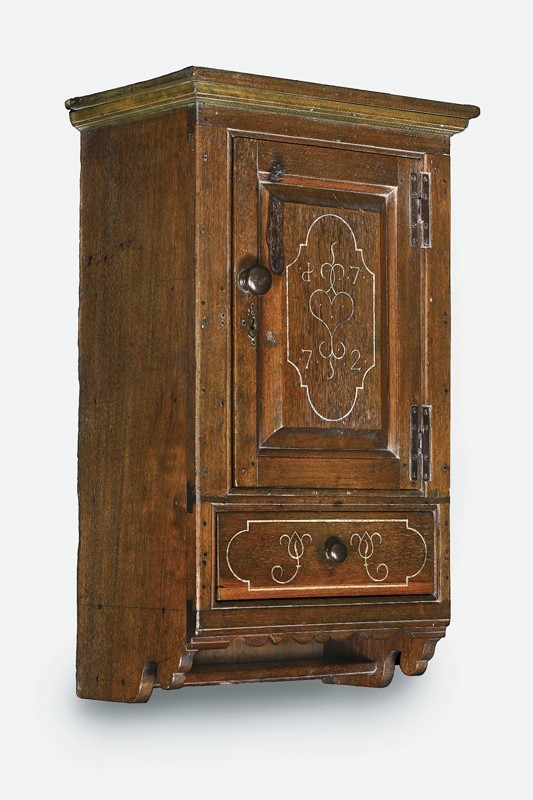
Hanging cupboard, probably Lancaster County, Pennsylvania, 1772. Walnut and sulfur inlay with pine. H. 33", W. 18", D. 11 7/8". (Courtesy, Philadelphia Museum of Art, 1953-125-9; photo, Gavin Ashworth.) The bottom lip of the drawer is replaced.

Detail of the inlay on the cupboard illustrated in fig. 207. (Photo, Gavin Ashworth.)
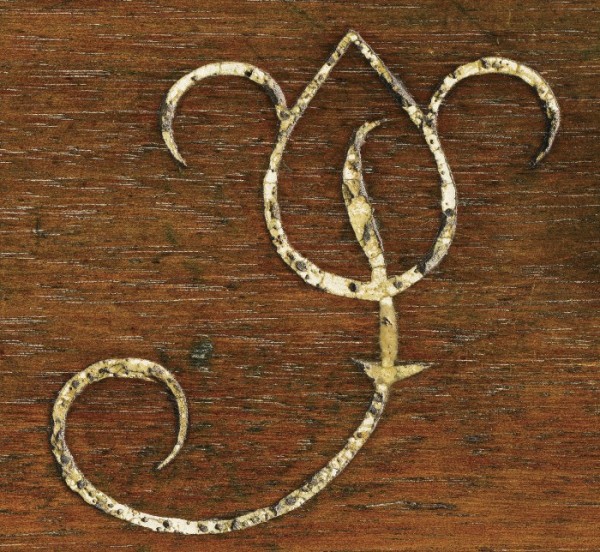
Detail of the inlay on the cupboard illustrated in fig. 207. (Photo, Gavin Ashworth.)

Tall clock, made for “J.K.,” movement signed by George Hoff, probably Lancaster County, Pennsylvania, 1774. Walnut and sulfur inlay with tulip poplar. H. 86 3/8", W. 20", D. 10 1/8". (Courtesy, Philip H. Bradley Co.; photo, Gavin Ashworth.) The feet are replaced and the inlay is restored.
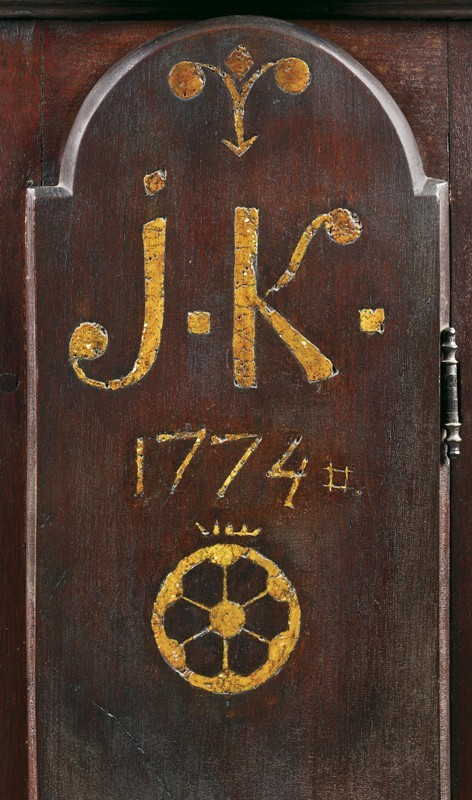
Detail of the inlay on the clock illustrated in fig. 210. (Photo, Gavin Ashworth.)

Tall clock, made for “H.S.,” movement signed by Jacob Gorgas, Ephrata, Lancaster County, Pennsylvania, ca. 1790. Walnut and sulfur inlay with tulip poplar. H. 95 1/2", W. 23 1/2", D. 12 3/4". (Private collection; photo, Gavin Ashworth.)
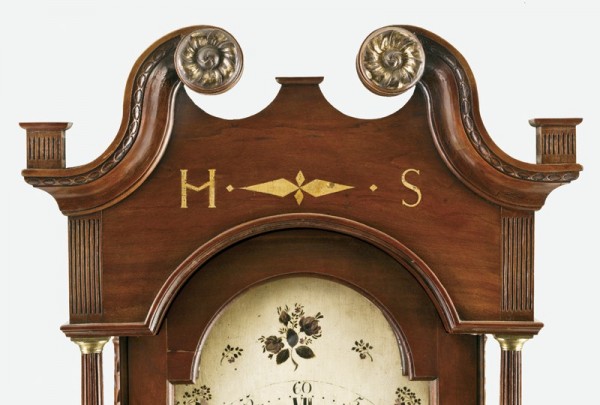
Detail of the inlay on the clock illustrated in fig. 212. (Photo, Gavin Ashworth.)

Table, possibly Lancaster County, Pennsylvania, ca. 1790. Walnut and sulfur inlay; brass. H. 30", W. 41", D. 29 1/2". (Courtesy, Carl and Yvonne De Paulis; photo, Gavin Ashworth.)
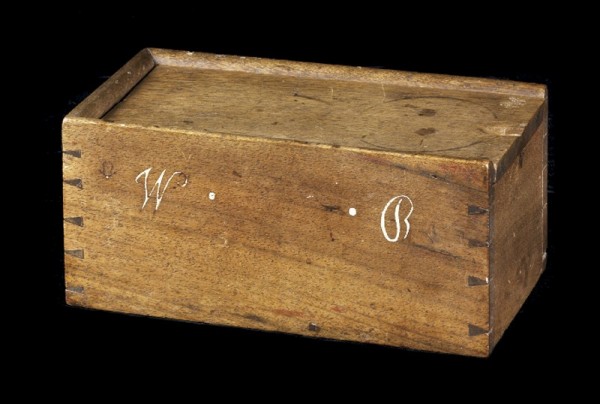
Slide-lid box, made for “W B,” probably Lancaster County, Pennsylvania, ca. 1790. Walnut and sulfur inlay with pine. H. 5", W. 11 3/4", D. 5 7/8". (Courtesy, Rocky Hill Collection; photo, Gavin Ashworth.)

Box with drawer, made for “M E,” probably Lancaster County, Pennsylvania, 1799. Walnut, sulfur inlay, and mixed-wood inlay with tulip poplar; brass. H. 9 1/4", W. 18", D. 8 3/4". (Courtesy, Rocky Hill Collection; photo, Gavin Ashworth.)

